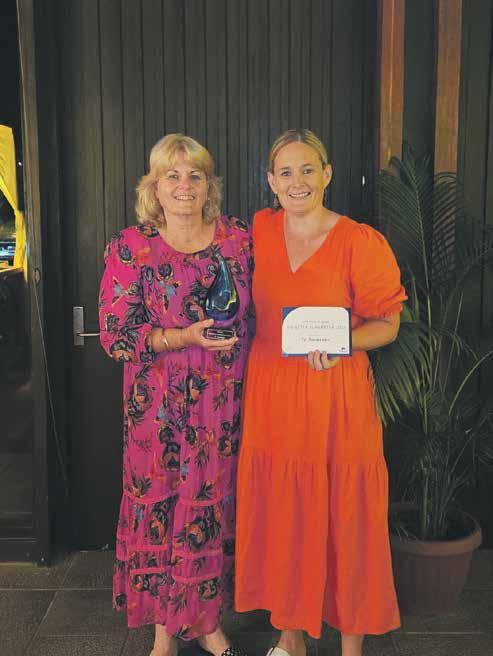King Country
news • business • opinion • sport





Police are urging King Country people to check bank details provided on invoices they receive by email after an Ōtorohanga business lost $11,000 to a scam.
Hackers gained access to the business’s computer systems and tampered with the invoices being emailed out, substituting their own bank details for genuine ones.
The customer paid the account because the work charged for was genuine, but the bank account on the invoice was not.
Sergeant Jimmie Walker of the Ōtorohanga Police said another customer avoided a similar trap in the nick of time.
The invoice was for $93,430.
“They tried to pay it online, the bank involved detected the scam and was able to cancel the transaction before it went through,” Walker said.
“We would recommend businesses use higher levels
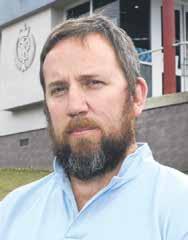
of security for their email and accounting systems, especially the more common two-factor identification processes which are now available.
“And if people receive emailed invoices and notice the banking details have changed from those used for previous payments, they should call the business owners directly to confirm that it is legitimate.”
Walker said this kind of scam had been around a long time, though it was seldom seen in Ōtorohanga and Te Kūiti.
He declined to identify the business concerned or say what goods and services it provided.
Adrian Leineweber, an online fraud expert who has run seminars on the subject at Taumarunui and Ōtorohanga, said he had encountered similar scams in south King Country.
“My suggestion is, if it’s a new company you’ve started dealing with, when you first set up the details in your online banking, ring the business and confirm their bank account details match those on the invoice,” the Mapiu resident said.
“After that, if it changes or is different to the account you’ve paid into before, contact the business to confirm with them before paying any money,” Leineweber said.
Fifteen per cent of Waikato commercial businesses have been the victims of crime, including cybercrime, five or more times in the last two years.
This was revealed at a Retail Loss Reduction Expo hosted by NZI in Hamilton today, where figures were released on how much crime is costing the business
community.
Executive general manager Garry Taylor said commercial crime rates reached a record high in 2022 and remained elevated throughout 2023.
“Notably, 85% of NZI’s commercial crime claims were due to burglaries and thefts, and 42% of crime claims lodged by retailers resulted from ram raids.
“The Waikato (which includes King Country statistics) has the second highest rate of commercial crime claims, after Auckland,” Taylor said.







The King Country App is FREE
Download it from the App Store or Google Play TODAY!

6 Progress Dr, Ōtorohanga • 07 873 4114 nidispatch@bulklines.co.nz
Country
Book your advertising space janine@goodlocal.nz

News/Editorial
Roy Pilott editor@goodlocal.nz 027 450 0115
Andy Campbell andy@goodlocal.nz 021 0232 1666
Paul Charman paul@goodlocal.nz 027 405 9038
Sigrid Christiansen sigrid@goodlocal.nz 022 080 6141
Advertising Director Janine Davy janine@goodlocal.nz 027 287 0005
Owner/Publisher David Mackenzie david@goodlocal.nz Office 07 878 1188 reception@goodlocal.nz
A King Country public hui aims to gather “local voices” on health - what is working and what isn’t.
The topic at Morero Marae in Taumarunui today (Thursday) is health and wellbeing, not just in terms of the medical system but also housing and other related issues. The meeting is at 1:30pm.
Ruapehu district councillor and Ngāti Hāua Iwi Trust member Fiona Chase said the organisers wanted to gather grassroot feelings about wellness.
Project kaiwhakahaere (co-ordinator)
Kuru Ketu of Ngāti Hāua said the findings from the hui would be used to compile
a report and help the iwi advocate for funding for the health projects and other needs identified by the community during the process.
The reporting will not name individuals.
The data is being gathered as part of a statutory process set in place in 2002, when the country’s 17 Iwi-Māori partnership boards were established. They had operated under Te Aka Whai Ora, the former Māori Health Authority, but now worked under the auspices of Te Whatu Ora – Health New Zealand.
The body responsible for the reporting process in Taumarunui - as well as the wider Tainui area - is Te Tiratū, one of 17 Iwi-Māori partnership boards in New
When I previously wrote about the Environmental Protection Authority’s Annual Report on 1080 poison (The News January 25, 2024), I commented on an incident involving dead bees and stated that 1080 may be contaminating honey.
King Country News published a response headlined “Contaminated honey claim refuted.” In the story Apiculture New Zealand Communications co-ordinator Karen Allan stated: “To the best of our knowledge, there is no evidence or record of 1080 contaminating honey in New Zealand.”
Considering the response from ApiNZ, it’s important to note that New Zealand doesn’t have an accredited method for testing 1080 poison in honey (OIA). Despite this, Landcare Research records show that 1080 poison residues have been detected in bees and honeycomb.
On 20 December 2002, a sample of honeycomb was received by Landcare Research, and was tested for 1080 poison (Ref T1837). The test result was positive. Two more samples of honeycomb were tested for 1080 in January 2003 (Ref T1843). Both samples were positive for 1080 poison.
Oddly, despite 1080 being detected in honeycomb in 2002 and 2003, no further tests for 1080 poison residues in honeycomb have been undertaken. (OIA)
Another poisonous bait widely distributed across New Zealand by hand and via bait station is Pindone, a first-generation anticoagulant toxin. It’s different in its killing process to 1080 poison, but similar in its cereal formulation. To wildlife, including bees, they’re both food.
Information provided by the Department of Conservation states that “Pindone residues were recorded in honeybees found alive and dead in bait stations containing Pindone Possum and Rat Pellets on the Ohau River,

Twizel in August –September 2014 (VPRD 18622-18629). There was also evidence that they had been collecting bait to take back to their hives.”
(OIA Ref 19-E-0439/ docCM6022211)

On 31 October 2014, Research Priority Leader - Wildlife Ecology and Management Team (Landcare Research) wrote by email to DOC that “many of the bees in the samples were carrying bait as they would pollen.”
In November 2014, test samples made up of 157 bees, alive and dead, were tested for Pindone residues (Ref T5678). All returned a positive result.
On 12 November 2014, the same Landcare Research Leader, stated by email that “the first four, Lab Nos 18622-18625), were individual bees that had visible green pollen sacks (as in the photos I sent) and were selected at random – so this group of results reflects relatively high concentrations being carried by one bee, potentially going back to the hive.”
The author goes on to say, “The difference between the “sampled dead” and “sampled live” results does suggest that ingestion of pindone bait was contributing to bee mortality.” Correspondence from Landcare Research states it has not tested honeycomb for Pindone.
The biggest advocates of poisons like 1080 – the Department of Conservation, and TB Free – fund the research that supports their ongoing use.
The company that imports 1080 poison and manufactures the bait (Orillion), is government-owned. Testing is undertaken by a Crown Research Institute. Perhaps it’s time for independent scrutiny when it comes to monitoring our food chain.
Zealand.
The boards are advocates for whānau and communities in their regions.
They help the Government understand local Māori healthcare needs and aspirations, and influence regional strategies, local priorities and design and delivery of healthcare services.
They also give feedback on how the health sector is performing in meeting the needs of Māori.
If the preferred of three bids for the Whakapapa Ski Field fails, the government will have to pick up the costs of dismantling the infrastructure.
And that has been put at between $47-$87 million, Ruapehu mayor Weston Kirton says. Tūroa and Whakapapa skifields on Mount Ruapehu generate winter revenue of more than $100 million which goes into King Country businesses.
Tūroa has been sold to the operator Pure Tūroa, which now has a concession to run it for 10 years.
Those who declared their interest in Whakapapa ahead of a May 10 deadline were Whakapapa Holdings; a former Tūroa bidder John Sandford and a pan-iwi group.
Meanwhile, Kirton is to launch a petition to Parliament this month requesting that it fast track efforts to find a new operator for the Chateau Tongariro.


Welcome back
I am all in support of the proposal that the King Country be again recognised as a province of New Zealand. In the 50s as a young lad whenever we crossed the Puniu River the big sign used to say “Welcome to the King Country ‘’. This disappeared many years ago, so let’s put it back and Professor Tom Roa you have my 100 per cent support.
Frank Lewis
Ōtorohanga, King Country
Livestream follow
As mentioned in King Country News (May 9), the livestream failed during the meeting. I voted in favour of selling the three sections. The sections are not part of Brook Park as reported.
Gavin Todd
Waitomo District Councillor


















A new movie in te reo Māori about the battle of O-Rākau will be the first in New Zealand cinema history to share the history from a Māori perspective. It will be released during Matariki next month on June 17 in Hamilton.
Film producer Piripi Curtis joined King Country News at the battle site during the recent 160th anniversary commemorations.
“This is the first time we’re telling the story from our own perspective. One that we’ve passed down from generation to generation, and is still felt today,” he said.
Set in 1864, Ka Whawhai Tonu (Struggle Without End) describes “a battle fought with impossible odds” between Māori and Government forces during the New Zealand Land Wars.
The film is set near Kihikihi and features numerous actors with
close whakapapa links to those who were there.
The young stars are Paku Fernandez and Hinerangi Harawira-Nicholas. They will appear alongside Miriama Smith, Temuera Morrison who plays Rewi Maniapoto (and is himself a Maniapoto descendent), and Cliff Curtis.
A team led by director Mike Jonathon spent five years on the project.
Curtis, a teacher by trade,

said the film medium’s emotive character would help New Zealanders learn about the battle of O-Rākau.
“Emotions charge your memory,” he said.
“When you’re caught up in an emotional story that we control fictionally, we heighten your emotions and therefore we heighten your retention and memory of what happened in the battle, and what was said.”
The story highlights the greatness of the warriors against extreme adversity.
“What they faced was courageous. It was 350 Māori, women and children included, versus thousands of colonial professional soldiers.”
Curtis said the kiriata (movie) is a fictional story where two teenagers’ worlds collide on the battle’s eve – in an “unlikely friendship” which becomes a beacon of light in the dark moments of battle.
Eventually the protagonists end up with a group of orphans seeking safety.
Fidelity to history was the filmmakers’ highest concern, Curtis said.

“We received the permission of the descendants to use their ancestors in the film.
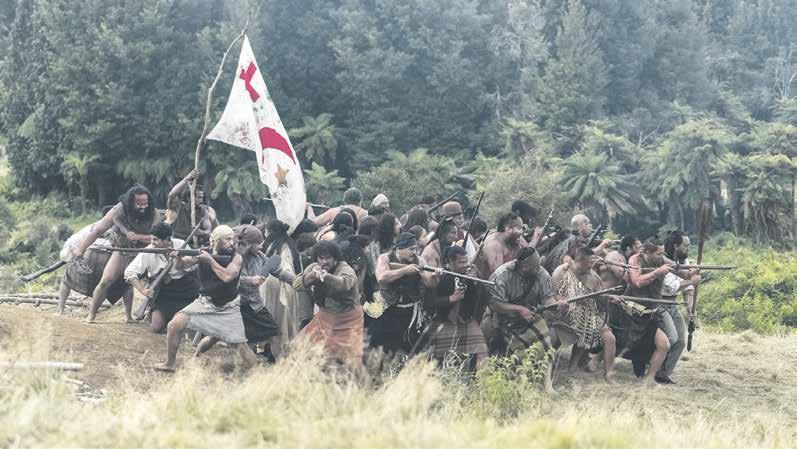
“Although the tūpuna are interacting with fictional characters, the important thing was to show the battle as accurate to the descendants and the iwi’s version of events.
“At the time, the colonial government had a tendency to change the reality of what actually happened.
“They overstated and understated where it suited their narrative.”
Curtis said it was a bit like the making of the film Titanic – a fictional story intended to be “dead set accurate” in its portrayal of history.
An example of this attention to detail in Ka Whawhai Tonu concerned the making of the set.
A 1:1 scale pā to match the real site was built using a GPS digger.
“We dialled up the dimensions and he dug it to scale, one to one.
“When you get inside the pā site you realise how crazy it was for them, to try and take on two and a half thousand soldiers with the latest technology.”




has ‘always idolised’ the artist, is making her own contribution to world of art and design: with gumboots.
Tamorangi Clayton Lake, a Te Kūiti High School

student and ringatoi (artist) creates patterned kamupūtu (gumboots) for friends and family. The 15 year old Year 11 student has been making them for about two years.
The kōwhaiwhai (traditional patterns) are created with coloured marker pens.
Art has been a big positive in Tamorangi’s life.
At times she had felt dismissed, including by kaiako, thinking of her as a ‘hori Māori.’ But art, and knowing who she was, meant it didn’t cut as deep as it could have.
“I’ve never been someone to get down. When you know your identity, it doesn’t matter.’
The student believes in loving what you do, and taking a positive attitude to your work.
“Don’t do the mahi to get the treat, make the mahi the treat,’ she said.
“And if people get stuck, and don’t know how they feel, just pick up a pen and paper. That will help them navigate,” she said.
At the workshop, she was inspired by seeing Mr G Hoete succeeding in the art world, and also by the hītori shared by Te Kūiti Pā trustee Isaiah Wallace.
A hard-won but decisive victory in the Year 8 boys race by hard working Pukenui student Stuncee Rapana was a highlight of this year’s King Country interschools cross country.
The event, held at Rangitoto School on Friday, saw 200 primary and intermediate age children from nine schools battle it out for running honours.
Host school principal Pip Were said she got lots of positive feedback about how the event was run.
“People appreciated that the races started on time.”
Stuncee and Piopio College student Mac Carter were closely matched throughout the Year 8 boys race.
“The two boys were battling the whole way – it was an extremely close finish and they both had incredible determination. They were neck and neck in the last long straight.”
Stuncee lives in Te Kūiti and comes from a sporty family – role model dad Jagger plays rugby and basketball, while sister Alairah plays netball, ki-o-rahi, rugby and touch, to name a few. He plays basketball in the under 14s although he’s only 12.
On top of the regular 15 minute around the block school practices, Stuncee went for longer runs, more like half an hour, “most afternoons” after school, off his own bat.
Kate Carter, mum of Piopio college opponent Mac Carter, said the winner had a run “a perfect race” and had passed at

the finish line with what seemed like “8’11” legs.”
Pukenui principal Raewyn Jackson said the school was “pretty proud” of Stuncee and felt the race would give him a welldeserved sense of confidence.
“It’s something exciting and new for him, a good chance to shine. It’s taught him some useful skills and he’s learned about himself. In the past he hasn’t always felt that he’s someone who is good at things.”
Pukenui sent about 26 students to the cross country, she said with the credit for the turnout going to teacher Dorothy Carr who did lots behind the scenes.
“We’re lucky to have a teacher who is so passionate about sports, and really gets the kids going,” Raewyn said.

Over the coming weeks we’ll be under taking an aerial sur vey of TLC-owned lines and equipment using helicopters.
The footage will help identify areas needing maintenance, repairs or even replacement of structures and equipment — keeping your lights on. It will also help us to keep our community and workers safe.
The survey is weather dependent. The aircraft will rapidly fly over TLC-owned lines and infrastructure — only taking visual footage of equipment, not of private property, people or livestock.
The official pipe band for the Great New Zealand Muster - and the most photographed pipe band in gumboots in the world, is celebrating 75 years of piping and drumming around the King Country.
Te Kūiti and Districts Pipe Band is the offshoot of former pipe bands in Piopio and Ōtorohanga. It had a strong membership until
1989 when it went into recess for nine years and was revived by current drum major Jim O’Halloran and Ōtorohanga piper
Lloyd Fitzgerald as tutor. Jim is the son of the founding drum major John O’Halloran.
There’s a tide in the life of pipe bands, particularly a rural band with larger centres nearby, said the band’s current pipe major Don McColl.
He’s seen about three rotations
as the band’s four core musicians; Keith Buswell, Bob Dawson, Andrea Price and himself, helped train up and coming young pipers and drummers who were lured away, to play for larger more competitive bands.
He understands the attraction of playing in a more musically demanding space, being a member of a Rotorua band himself. But he wants it made clear that for the parades that
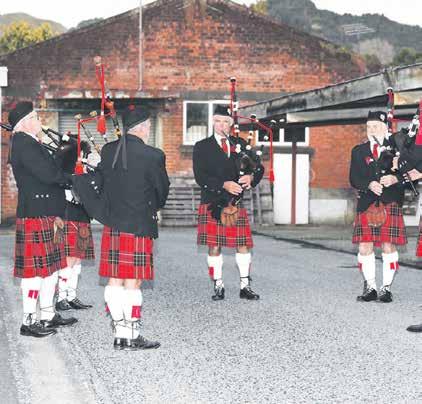

count for the TK&D pipe band, the musicians are able return to their home band.
“We don’t mind them playing for bigger bands, that’s the way the world works, but for Anzac/ Christmas, we expect to see them play for local bands,” he said. “Most get it, but others have to be told.”
The tide worked the other way for the band about 2010 after a Hamilton band dissolved
and T&D pipe band received a number of new pipers and drummers.
The boosted numbers encouraged the band to compete, and the band competed at its first national contest in Masterton in 2010 in Grade 4.
They won the Grade 4a National Contest in Timaru in 2013 with 19 pipers and 10 drummers and last competed at Grade 3 in 2015.
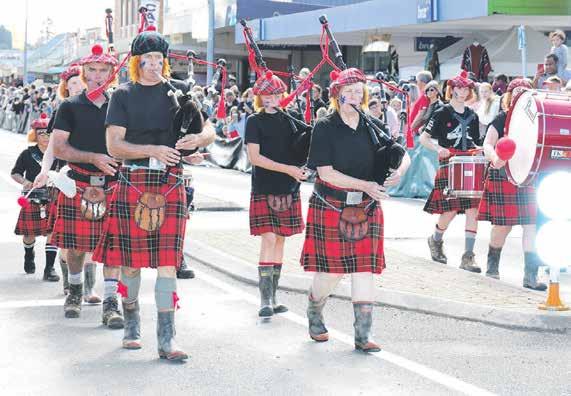

•
Don’t wait any


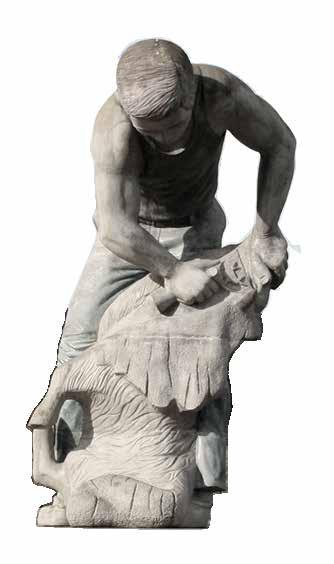
Waitomo District councillors acknowledged criticism of the council’s legally required waste minimisation process, at thier deliberation of submissions to the Draft Waste Management and Minimisation Plan 2024.
Te Aomarama Anderson had concerns about an inadequate consultation process, submitted the Hamilton consultation on their plan was better, and that Waitomo District council’s consultation on its own Centennial Park development proposal, was superior.
She also wanted marae included in the planning process from the begining, in partnership with the council.
“It is inappropriate for council to include marae as one of four targets in this plan as it infers to the community that marae are sites of waste creation, and it publicly obligates marae to participate in this target for it to be fulfilled,” she

submitted.
Marae were already involved in waste minimisation through the Para Kore programme and could have shared that knowledge in the creation of the plan and its targets, she said.
(Established in 2010, Para Kore Marae Incorporated is a Māori not-for-profit organisation working towards zero waste through collective action for a zero carbon, zero waste, Aotearoa, New Zealand that honours mana Māori motuhake and regenerates Ranginui and Papatūānuku.)
Te Aomarama said the council plan lacked ambition by defaulting to a national strategy when Waitomo could make local changes and become national leaders.
The time frame was also too long. A scoping project could be completed this year to determine future actions. It did not have to wait until 2030.
“We need brave ambitious leaders that

push for systems change and a reduction in waste creation (minisation) vs diversion of waste created (managment). We need to aim to be operating higher up the waste hierarchy. We should not be falling back on national approaches and strategies as an excuse to inaction,” Te Aomarama submitted.
Meeting chair deputy mayor Allan Goddard said Te Aomarama raised some very valid points.
“And I would like to thank her for the effort she went to for that, particularly for the proposed target around marae,” he said.
The plan implied marae were big waste producers when they were not, he said.
“And when we are targeting them for education, I see in the proposals we could change that target a litle bit - but I’m just not convinced we should have that target there.”


































Former Te Kūiti man Karl Thurston, 34, reached the quarter finals of a race at the BMX World Championships in the United States at the weekend. Thurston, who now lives in Tauranga, was attending the event with a large contingent of Kiwi BMX riders, including fellow Te Kūiti member Lee Chapman.
The racing in Rock Hill, South Carolina ran all last week, finishing on Saturday.
Though recovering from a gastric bug, Thurston competed in both cruiser and 20-inch wheel events. He surprised himself by reaching the quarter finals
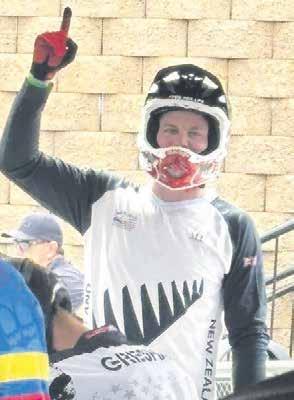
in a cruiser class, which has bikes with larger wheels. It is a category he doesn’t usually race in.
“When I completed my racing for the cruiser class I was 24th in the world standings, but unfortunately a crash happened in front of me in the 1/8” finals hindering my race and that was me done for the day,” he said.
“That’s racing though, you have to accept these moments as it’s so fast and you only get a split second to make a decision that can make or break your day and it’s a thrill.
“In my 20-inch class I finished up world 29th. We got to finish our three moto races and I was feeling really
good, I was excited to get out there for my 1/8” final, but the weather gods sent a lightning storm and over the USA and they take them really seriously here. The finals were cancelled, and we all had to accept that we could not go out there and battle for a better finish. BMX is a do or die sport and it teaches you to be resilient in these moments.
Thurston, a diesel mechanic, attended the world championships with his wife Amy and their two children, Issy, 6, and Mia,3.
Though an avid racer in younger years he only returned to serious training about two years ago.
He well remembers his start in BMX,
which involved taking up the sport as a young child at Te Kūiti.
“I love Te Kūiti, the King Country and everything Te Kūiti and BMX ever gave me. It was about locals helping locals, having a laugh but (seriously) racing to see who’s faster or who can do the bigger jumps.
“I have nothing but good memories of Te Kūiti’s old and new tracks. I don’t know where I’d be without Te Kūiti BMX it’s been, the people involved are the heart of it all.
“I was never the fastest kid I just loved to ride my bike and hang out with my mates and hoped one day I would beat them.”
Aria school’s annual book fair gave students the opportunity to dress as their favourite book characters this week, said Principal Pam Voyce (aka Pocohantas).
Little Bo Peep, Hermione Granger, an Elsa, a bear, a rugby player, several little hunters in cammo (not based on any book in particular) were joined by teacher aide Nicole Hurley in lime green leprechaun mode, and ‘cavewoman’ whaea Ana Wiseman.
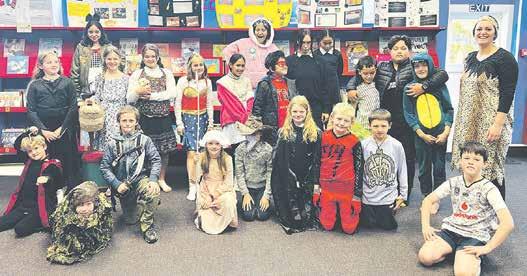

















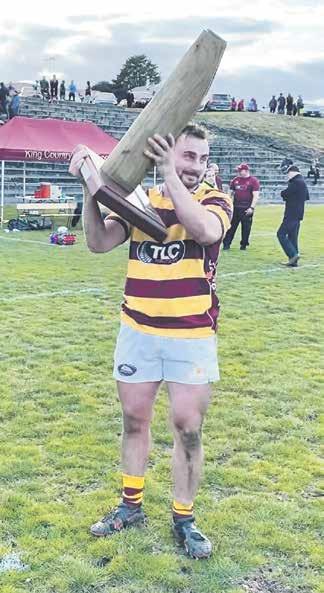 By Paul Charman
By Paul Charman
With their challenge for the Ranfurly Shield just four weeks away, excitement is building among King Country Rugby Union players and supporters who get a chance to cheer the team on tomorrow.
The Rams are to take on the Hawkes Bay Magpies at the Hastings High Performance Hub on June 26.
The wider squad, which has been training behind the scenes for weeks, had its first get together last week, King Country Rugby Union general manager Kurt McQuilkin said.
And tomorrow the Rams buildup will be enhanced by meeting their Chiefs Country and Heartland rivals Thames Valley in Hamilton as the curtain raiser to the Chiefs v Hurricanes game.
“It’s a wonderful opportunity and a valuable part of buildup for Hastings,” McQuilkin said.
“Both unions have agreed they will only play local players on Friday – no loan players or players of origin. Each of those players will get a cap for their province and that’s making it a first class fixture. After that

Are you looking for a job that makes a difference in the community? Do you want to be part of a team that has a true purpose? Do you have what it takes to become a Police Officer.
New Zealand Police are on the lookout for new recruits from the Ōtorohanga and surrounding districts. You must be at least 17 years old to apply and 18 when you start at police college. There’s no upper age limit
The Ōtorohanga Employment Hub will be hosting local police, recent graduates and their recruitment team to talk to the role and the application process.
The information evening will be held at The Business Collective, 12 Hinewai Street Ōtorohanga on Wednesday, June 5, 2024 at 5.30pm
To save your spot call 0800 OTOJOBS (0800 686 5627) to register your interest or email apply@otojobs.co.nz

they’ll start ripping into the trainings sessions as we build toward June 26.”
Meanwhile, two of the players who will run onto the field at Hastings played for Hawkes Bay development sides earlier in their careers. They are captain Liam Rowlands and teammate Cameron Robinson, a utility man, both of Taupō.
“The Hawkes Bay side they are going to be putting out will be devoid of super players, but it will contain some on the periphery of super rugby and some of their top club men. It will be a big challenge for our lads but one they’re looking forward to,” McQuilkin said.
“As much as anything else, this kind of game is about setting yourself measurable goals that you want to achieve throughout
the match. It’s not all about the scoreboard. But who knows – there’s a possibility that there may be a fairytale ending isn’t there?”
There would be no ticket sales at the Hastings High Performance Hub, “just most likely the old school stuff of a few bucks to get through the gate,” said McQuilkin.
“The King Country Rugby Supporters Club, recently formed by exTaumarunui supporter
Ryan Gulbransen, who now lives in Hamilton, has had its phone lines running hot from people asking about buses to go down to see the game, which is great.
“And I believe the Saracens Rugby Club are putting on a pre-match function for the King Country supporters.”
The year 2016 was the last time King Country had

a Shield Challenge (a 55-0 loss to Waikato) and the Rams have not played the Magpies since 1969.
In that game, after trailing 6-19 at halftime, captain Colin Meads is said to have inspired a secondhalf comeback, falling short 16-19 in what remains King Country’s closest Ranfurly Shield challenge.
Te Awamutu darts player
Mark Cleaver has won a spot competing with the biggest names in darts.
Cleaver, known as the maestro (because of his guitar playing) confirmed his place in the Hamilton event at the DartPlayers New Zealand ProTour double-header this month.
Cleaver’s support crew from Te Awamutu Darts Association will be in full support, at the darts and in costume. Most will dress as maestros.
Cleaver, Kayden Milne and Ben Robb finished in the top three of the rankings and will play in the New Zealand Darts Masters on August 16 and 17.
The event attracts the biggest names in darts and should include 17-year-old English wonderkid Luke Littler and new world champion Luke Humphries.
Former New Zealand Darts Masters champion Gerwyn Price and fellow former world champions Michael Smith and Peter Wright have also been included, while UK Open champion Dimitri Van den Bergh makes his latest appearance Down Under. Other New Zealand representatives confirmed are Haupai Puha and Simon Whitlock. Three-time world champion Michael van Gerwen and World Matchplay champion Nathan Aspinall will miss
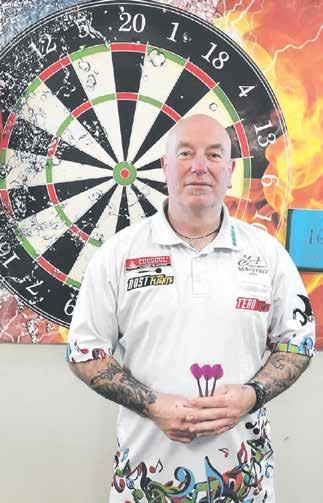
the event for family reasons.
The night at the darts promises to be an over-thetop blend of high-level sport, wild fancy dress costumes, big 180 calls, and largerthan-life personalities.
Cleaver started playing darts when he was aged 10 and was originally considering golf before darts took his interest. There’s no age limit in darts, he said.
“One player is 82 and he can still throw a good dart,”
the 56 year old said. He has and does play internationally. He enjoys the camaraderie, the competition with players at a level, but adds that how a player handles the stress is a big factor in outcomes. His family is grown, so it’s one less stress factor when he is away most weekends. Pro darts is a big commitment. “People don’t see the work hours at home on the board,” he said.

The poor driving choices of motorists using King Country roads are more than a passing irritation for Ōtorohanga Volunteer Fire Brigade chief Neville King and his colleagues.



Several times a month bad driving means King and his fellow fire fighters must turn out to crash scenes to pick up the pieces.
These occur on country roads and main highways; they involve anyhting from single vehicles failing to take corners to multiple vehicles involved in collisions.
Volunteer fire fighters in Ōtorohanga and neighbouring communities turn out at any hour of the day or night and in all weathers to assist trapped or injured drivers, secure crash sites and facilitate transfer of the injured to waiting ambulances, or rescue helicopters.
And though not every crash is caused by blatant human error, many of them are, says King.
“The biggest problem is people
in vehicles without a hands-free device either speaking or texting on a mobile phone while driving.
“Driving is a serious business and it deserves your full attention; there so many examples of crashes which cause serious injuries, or even deaths, being caused by drivers using their mobiles illegally.
“We certainly see evidence of it in our area.”
King added that there was a wider issue involving inattention of many kinds.
Some who drove around wearing headphones looked - from the standard of their driving - as if they were more concerned with their music than with staying safe on the road.
“For one reason or another it







seems that many drivers who get involved in crashes in our area are simply not concentrating on what they are doing.
“Perhaps they get distracted, or start thinking of other things, or perhaps they were stressed before they got in their cars and went for a drive.
“All this can add up, and when combined with other factors, such as inexperience or driving on wet or icy roads, the result can be disastrous.
“It doesn’t take much to send a distracted driver’s vehicle into a ditch at the side of the road.”
King added that in his view it was a shame new drivers had such ready acces to high horsepower automatic vehicles.
“In a previous era most of us started out driving low-powered manual cars, but at least this gave us time to get used to driving. Most of us picked up a wider range of driving skills over a longer period, before ever getting behind the wheel of a more powerful car.
Ō
20-26 May 2024
you drive you need to treat the experience with respect and keep your wits about you.

torohangaVolunteer Fire Brigade chiefNeville King .
“Excess speed, lack of patience and failing to drive to the conditions are also factors behind a lot of crashes. Every time
“Above all, don’t get aggrivated, even if somebody in front of you is doing something wrong or going too slowly.
“It’s essential not to try to pass until it is safe to do so. What does it matter if you a delayed a few minutes; better to be delayed or even be late, than to be involved in a
crash.
“We (fire fighters) tend to take these habits on board because we see the consquences of what can happen when things go wrong. But even little things help, because many things add up to make you safer of the road.
“I’ll give you just one small example: This morning it was frosty and many people’s cars had iced-up windows.
“How long does it take to get a jug of cold water and use it to ensure the front and rear windscreens and side windows are properly clear from frost.
“Fussing around with a jug for a few minutes before work is better than potentially paying the panel beater following a crash.”

Pip Were has been appointed Kio Kio school’s new principal.
The current Rangitoto school leader starts in the third term and said she feels “almost overwhelmed” farewelling the students and grownups she’s come to love.
“I will 100 per cent miss this school and community.”
Were is also looking forward to getting to know a new cohort of children at Kio Kio, which is the larger of the two kura.
“In many ways they’re quite similar – both small rural schools. I think it will be a really lovely school to lead.
“I am staying in the area and will continue to be involved in sport and all the things we do here.”
Rangitoto school board of trustees chair Sam Duder said he had “mixed emotions,” and knew it had not been an easy decision.
“We feel the loss of an exceptional principal but fully appreciate the career development opportunities which Pip has chosen to explore.”
Were lives north of Te Kūiti with farmer husband Brendan, and three children Annabella, 15, Jack, 13 and Sam, 11. Most family members are keen horse riders, with the younger ones making their mark in a wide range of Pony Club disciplines.
She told her new school

in the newsletter that she was looking forward to guiding Kio Kio students on their learning journey.
“I aim to help them discover their identity and value through our educational, cultural, and sports programmes.
“By adopting a strengthsbased approach, we will foster their self-worth and instil the Kio Kio School values of perseverance, ownership, wonder, excellence, and respect.
“This prepares our students to become literate, numerate, and functional members of our community.
“I am really looking
forward to meeting all of Kio Kio School’s students, staff, whānau, and the wider community to build strong relationships.
“I encourage all parents and whānau to get involved and share their ideas, as your input is invaluable. My door is always open, so feel free to come in and say hi.”
Kio Kio School board member Karen Thompson said Were’s leadership would have a positive impact on the school.
“We look forward to supporting her in the on-going success of our treasured school and its community.”

Ōtorohanga
Police attended six family harm incidents.
May 13: At 2.55 pm police were called to a single vehicle crash on Ngutunui Rd, Puketotara, in which a white Toyota Hiace van lost control on a corner and hit a bank. The vehicle rebounded and ended up on its side but the driver was uninjured.
May 17: Between 8am and 11.30 am a black 2006 Mazda Atenza was reported stolen from a rural address at Puketotara. The vehicle was later recovered from Ōhaupō.
May 18: At 11.20am a white 2008 Holden Rodeo was stolen from Honikiwi Rd, Ōtorohanga. The vehicle is still being sought by police.
Te Kūiti
Police attended four family harm incidents.
May 13: at 2.30 pm, at Te Kūiti, a Toyota truck pulled out of a driveway into the path of a brown Toyota Hilux. This resulted in a minor collision but no injuries were reported.
May 13-14: A mailbox was stolen from an address on Pukenui Rd, Te Mapara. It was valued at $200 and described as the newest mailbox on the road.
May 14: At 7am a shoplifting incident was reported at the Four Square Supermarket, Te Kūiti. A woman had entered the store, placed beauty items and toys with an estimated value of $120 in a bag, and left without paying.
A fire crew from Piopio faced “a most unusual situation” when they rescued a kitten from toilet at a house in the village last week.
Piopio fire chief Darren Cathie said the brigade recieved a call at 2.49pm, on May 15, after a child apparently attempted to flush a kitten down the household’s toilet.
“He partially succeeded because the kitten’s back legs were stuck in the S bend. We got the stressed animal out alive, though it wasn’t very happy, and we didn’t need to damage the toilet while extracting it.”
May 15: Between 3pm and 3.15pm an incident of shoplifting was reported from the Super Value Store in Te Kūiti. A man had entered the store, picked up boxes of port and beer, and left the store without paying for them. The items were later returned after staff intervened.
May 19: At 9.43 am the driver of a grey 2008 Subaru Legacy was stopped on SH3 at Waitomo and processed by police for driving with exactly 400 mg of alcohol per litre of breath.
Benneydale
A single family harm incident was attended by police.
Taumarunui
Police attended 13 family harm incidents and a mental health incident.
May 14: Patio furniture was advertised on Facebook and a deposit paid but when it was time to pick it up the occupants of the address knew nothing about it. A burglary was reported on North St.
May 16: Warrants to arrest were issued for several people failing to appear at court. Police received a report that a person had been scammed out of a small amount of money from an overseas website.
May 18: The driver of a vehicle that crashed into a pole on Taupo Rd refused to undergo blood alcohol procedures.
Te Kūiti
A crew from Te Kūiti was put on standby but not needed.
The Ōtorohanga bridge also had a fairly low key week, with callouts limited to assisting St John Ambulance crews with medial cases on May 14, 15 and 18.





A man described as an iconic stock agent, Alan Douglas (Hizzy) Hiscox died at his Taumarunui home on May 2.
In a career stretching back to the 1970s, Alan became a top Central North Island auctioneer, following humble beginnings as a National Mortgage Association trainee from Feilding.
As one of the company’s front men, he was regarded as a talented operator, telling the King Country News in a 2016 interview that he prided himself on always doing his best for both client and company.
“‘Hizzy’ always did things his way,” fellow auctioneer and friend Carl White said.
“He was truly iconic in my view; though he only really sold in the Central North Island, he was second to none, definitely under-utilised.”
White said Alan outshone many others due to his presence and his diction – you could always understand him.
“Beyond that, one of his greatest assets was knowing the market. He had orders; he always knew where to place cattle and sheep.”
King Country News files preserve some of Alan’s own comments on his career:
After being promoted from general office duties as a young man, Alan said he naturally took to the role as a stock agent and never looked back.
“I had no experience in the livestock industry and as a young fella I was just looking for a job and I ended up at NMA.
“They were advertising for a trainee so I basically grew into the livestock game rather than coming off a farm or anything like that. But it’s an industry that’s once you are in it you don’t really want to do
anything else.”
After finding his feet in Feilding, Alan was transferred to Wrightsons in Taumarunui in 1984 and felt right at home.
“I accepted a transfer back to Feilding in 1987 but I didn’t want to leave Taumarunui,” he said.
“I liked the three Ts – Te Kūiti, Taumarunui and Taihape.
“They were hill country farmers and I liked the way they operated.
“After only about a week back in Feilding I didn’t like it but I couldn’t go back to Wrightsons because I had resigned so I became an independent.”
Operating under Alan Hiscox Livestock, one of the first independents in New Zealand, he returned to Taumarunui and remained there all his days.
Soon after his return, Taranaki Farmers purchased Fagan Farmers in Piopio and Te Kūiti renaming it King Country Farmers.
Alan was approached by King Country Farmers to sell his business, which he didn’t, instead agreeing on a 50-50 partnership and King Country Farmers Livestock was born.
Taranaki Farmers then acquired Manawatu Farmers and Waikato Farmers becoming Allied Farmers and then – New Zealand Farmers Livestock Ltd.
Through it all Alan said he specialised mainly in sheep and beef because of the down-to-earth way that industry does business. His area covered Te Kawa to Mōkau.
“Cattle farmers, right from the first day I started dealing with them – what you see is what you get.
“Still to this day they look you in the eye and shake your hand on a deal.

“The average day-to-day transaction between two farmers and the stock agent who makes it happen, is just a handshake.
“Everyone pays and that’s what it has always been like.”
A complex job, Alan said the main role of a stock agent was to do everything they could to achieve the maximum value for the farmer who has trusted them to do their business.
And having good old-fashioned values went a long way to doing just that.
White noted that Alan had both an amazingly high IQ and a dry sense of


humour and was capable of lively repartee.
“But this was never cruel; it was always just banter.”
Alan was made a life member of the Taumarunui Eels Rugby and Sports Cub about a week before his death from cancer, receiving his jacket at a ceremony at his home. Over the years he had taken on many roles within the club.
Alan is survived by his wife Arlene, their children Nathan and Kelly and their grandchildren. His funeral was held at the Taumarunui Cosmopolitan Club last week.






The latest reprint from the ‘May series,’ ‘No one went to Town’ depicting the adventures of a settler family living near Piopio (in one book), will be available at the end of this month.
The five popular stories were first published over 40 years ago by author Phyllis Johnston about her mother May’s life.
Many who read the books as children and remember them fondly have introduced them to their own families.
Among their hordes of young readers are adventurous girls who love to read about tomboy protagonist May.
Meanwhile, “boys who don’t read, read these books,’ the late author’s granddaughter Nia says.
“That’s because the main character might be a little girl, but there’s lots of gory detail… and three big brothers who play a big part in the stories, she said.
“They are country kids having a great time in hard times.”
The King Country connection is solid: readers around the Waitomo district connect with the stories especially, because the second book of the five, “Black Boots and Buttonhooks,” is set at Paemako, just south of Piopio.
Phyllis died in 2021 at 86, but her descendants have taken the reins of the book process, making sure it’s available to families and schools across New Zealand and the world.
Profits go entirely back into reprinting the books, so they are accessible to as many children as possible.
KC Farmer spoke to Phyllis’ granddaughter Nia, who together with her powerhouse mother Mary (the daughter of Phyllis) is the custodian of the series. Nia

ships the books, while Mary masterminded many of the book production tasks, including commissioning professional edits of the (formerly unpublished) last book in the series.
Nia is dairy farming with her five children in the same valley featured in the first book: Tututawa, in Taranaki. She met her husband in Auckland, but that was his home.
“We couldn’t move the farm to Auckland, so I moved down to Taranaki instead,” she said.
The books are a huge part of their lives. Today, Nia’s children get a thrill when they drive up SH3 past Paemako and see the old school, she said.
Phyllis always hoped the books would be available again, but there was a break of about 20 years from the late 1990s, when the books were out of print.
Kelly Madden, a teacher at Omata school in rural Taranaki, told the family the books had such enduring appeal that her pupils’ parents were “stalking” second hand bookshelves and TradeMe looking for battered copies.
“It would make me so happy to reprint the books,” an elderly Phyllis told her family when the idea was first raised.
Phyllis started writing in her forties after her children had grown up.
She was a creative person who needed an outlet, Nia said. Writing became that to her.
Nia is 44, and she remembers going to some of her grandmother’s book launches in the 1980s.
Phyllis started writing the series longhand, in pencil. The very first words were scribbled on brown paper which had recently wrapped the household butcher’s
order, and still smelled a bit like the contents.
“She found her thing,” Nia said. As a child, Phyllis had enjoyed books like ‘Little House on the Prairie’ set in the US and wondered why there was no New Zealand equivalent. She set out to write her own.
The author only later got a word processor, and her son-in-law had her play Solitaire on the computer to get used to using a mouse, which she never done before. She didn’t understand how to double click at first.
Yet she became skilled at corresponding with her readers by email.
But that was it. To the end of her life, she would send emails (at least until her sight failed in very old age) but refused to browse the web:
“I only have the email,” she would say to her family.
May was still alive at that time so Phyllis was able to ask her and other relatives questions as she wrote.
May later died after the first book was published, at the age of 90.
Phyllis did “a huge amount of research,” and once rescued the paperwork of a former dairy cooperative mentioned in the story – from its storage place underneath a tank stand on a farm.
This meticulous approach means that in last book in the series – featuring the adult May – goes into great detail into the dairy farming lives of share milkers in the rural Waikato during the 1930s depression.
Nia says the books’ value is that they show kids today how their great-grandparents lived – taking bread and dripping for school lunches, for example.
“It gives them perspective.”
When you think about subdivision, there’s a lot more than meets the eye. And for CKL, a company founded in Te Awamutu more than 35 years ago that has expanded across the North Island, this is certainly the case.
Hamish Ross, one of seven directors and who is based Te Awamutu, says his company takes pride in the fact they know the rural land and its people of the King Country and Waikato very well indeed.
“Our Te Awamutu office works with all the local councils but primarily, Waipa, Waitomo and Otorohanga and there is no doubt it’s harder than it used to be when we look at all the compliance requirements on farm, from Resource Management through to Government legislation and regulations,” Hamish says.
“Given that things only tend to get harder, there’s probably no better time than right now to sit down and have a look at what we can do, especially before the district plans come up for review again.”
Farmers often have a variety of scenarios that could work for them which can range from slicing off a couple of sections to release equity, protecting native bush or vegetation to generate a subdivision opportunity, subdividing off surplus farm dwellings, selling land to a neighbor or relocating existing farm titles to better fit the farm’s needs.
“A 5000sqm lifestyle section is going

to generate a reasonable profit while not having a great effect in terms of overall farm production. Often these lifestyle blocks can be positioned so as to minimize the disruption to the running of the farm and provide a great way to release some equity. Some farms that are located on the town boundary may also have a zoning that allows for more intensive rural residential development.”
This is where CKL comes in particularly useful because the size of the company means they have instant access to a range of professionals from resource management planners and civil engineers to land surveyors and environmental engineers. They also have partnerships with other rural professionals that work with them to achieve the right outcome for their farmer clients.
“As CKL have been around for so long, we know what the farmers want and also how to work with Council
and other professionals to create a development that works for all parties.”
Many farmers today are looking to diversify their farms; creating additional income via different markets ranging from forestry, kiwifruit to other horticultural crops. The reality is that creating that diversification and ringfencing it within a separate title makes good sense from a business and an asset protection perspective.
Another factor to take into account is farm succession which can be looked at a couple of ways.
“You may have a farmer who has a child who wants a farm but can’t afford to take on all of the family farm at this time. Mum and Dad can carve off some land for the child to buy and get up and running and later, once some debt has been paid down and land values have gone up, use the equity generated to buy more land.
“Or they may want to separate the main farm between kids,” Hamish
says. “Either way, it’s where CKL put to excellent use their years of expertise in the field.”
Hamish looks back on CKL’s 35 years in the area and is proud to be a part of the farming communities that they work with in addition to the depth of local knowledge in the region that he and his staff have.
“We are experts in all forms of rural subdivision from creating lifestyle blocks to new Titles that are hundreds of hectares in size. We can also assist with land use consent applications, farm boundary marking, drone surveys to map out paddocks, easement surveys to protect water and access rights and covenant surveys.”
“Rural is what we know, it’s what we do, and we get a kick out of helping farmers realise the best value from their land. We work with our farmer clients from start to finish to guide them through the process so that it’s as easy as possible.”
“Pick up the phone for a no obligation chat to discuss what opportunities might be available for you – you might be surprised with what we can help you with.”

Logan Dawson of Waipa, used data driven decision making to double dairy farm revenue.
Dawson, who with his wife Sian was runner up in the 2024 Dairy Industry Association Awards Share Farmer of the Year Award, is making $10,858 in gross farm revenue per hectare compared to the average $5856.
Judges said the Dawsons were continuously looking for more efficient and accurate ways to do things.
“I have managed to move from 13 kg of dry matter per kg of milk solids down to 11 kg,” he said. “That’s a 15 per cent reduction in feed for the same production.”
They’ve done this keeping a tight rein on every possible piece of farm data, feeding it daily into Google Sheets and sharing access across the entire Ngāhinapōuri farm team.
Data-driven decision making enhances accuracy, insights, and organisational effectiveness.
“Because it’s cloud based it means that our staff can access it at the same time as us,” he said.
The Dawsons are equity partners and 50/50 share milkers for leading dairy farmers Jim and Sue van der Poel on their 333ha, 1350-cow farm.
They employ six full time staff who, thanks to a satellite connection, have access no matter where they are on the farm.
“All of our planning and calculation can be done remotely. If I am doing sports, I can make sure that everything is being successfully monitored. There’s a lot of scope for successful on farm manage-
ment.”
Dawson created his system from scratch after searching for a software solution and finding nothing that fitted his specific needs.
His bespoke spreadsheet system includes a grazing plan detailing how much supplement to include in different sized GPS tagged feed bins, a fertiliser plan showing how much nitrogen and effluent has been applied, a mating plan, and a staff roster.
“I update it and the staff check it daily,” he said
“One of the benefits of Google Sheets is that you can go back in version history and see what has been happening. It’s just these little things that simplify everything.
“I am in the process of exploring how to turn it into an app to make it simpler and marketable I have not met many people that looks at things the way I do. I am really enjoying challenging thinking,” said Logan.
“His spreadsheets make his job a heck of a lot more efficient,” said Sian.
“Having five kids aged 10 months to 12 years it means we get more with him home a little bit more and makes for a better work and life balance.”
She describes herself as her husband’s sounding board, also supporting farm income with off farm photography.
“I love to take family portraits. A lot of the time I do it on farm. It’s a great little side business.”
Of being placed as a runner up, Sian said: “I am stoked. To be recognised on a national stage is amazing. To be second in all of New Zealand is a massive achievement.”
The Dawsons won two merit awards:
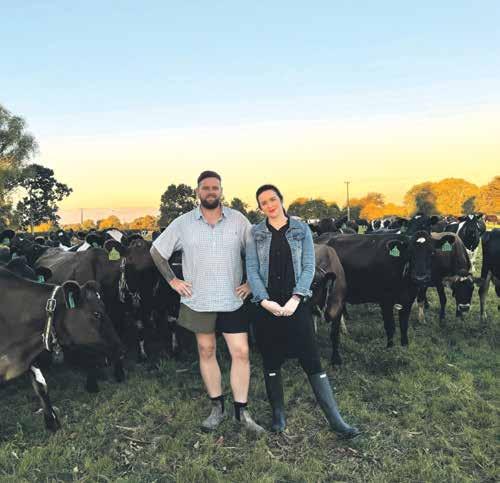
the Federated Farmers Leadership Award and the Honda Farm Safety, Health, and Biosecurity Award and more than $28,000 in prizes.
“Logan and Sian are on a large-scale, high input system 5 farm and are guid-
ing a lot of people, adding another level of complexity,” said DairyNZ judge Steve Canton.
“Through the use of technology and careful monitoring, they are really getting the most out of what they do.”




















Nithmount Farm Cow 494 affectionately nuzzles 2024 New Zealand dairy trainee of the year Kirwyn Ellis.
The encounter in a paddock on Hamish and Sharee Germann’s 130ha dairy farm - nestled between Mt Pirongia and Mt Kakepuku in the Waipā district – illustrates how Ellis, 20, cares for his herd and its environment.
The fifth generation Pirongia farmer has been at it for as long as he can remember takes his roles in kaitiakitanga
ronment that they have farmed in.”
Ellis won the award earlier this month. Described by judges as a relaxed, thoughtful, and mature young man who absorbs knowledge from those around him, he is a strong team player with a heart for his community.
He excelled across all categories, demonstrating effective communication skills. He maintains a good work-life balance and enjoys outdoor activities.
Judges praised him as a down-to-earth farmer who genuinely cares for others and serves as a role model for the industry.
Dad were more than happy to take me out
“The whole soaking up knowledge thing
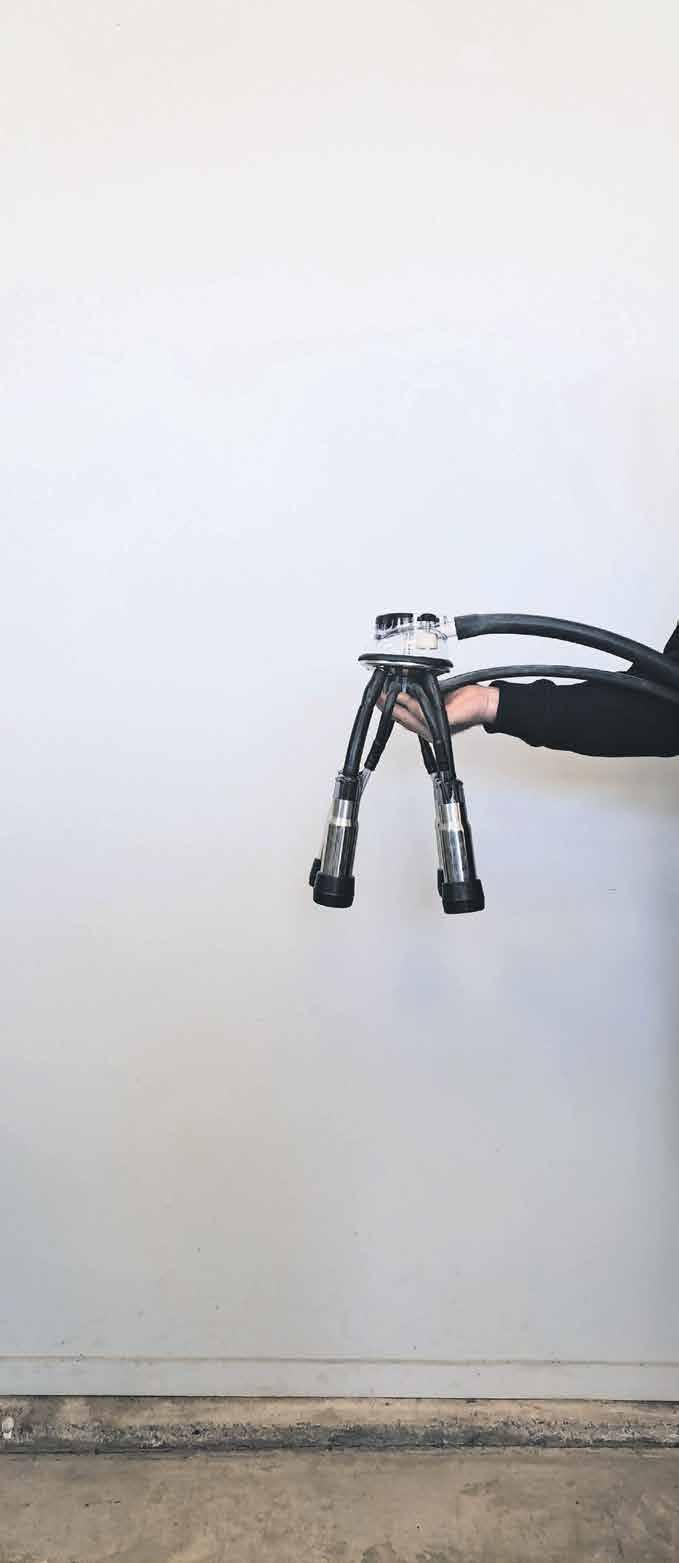


Farm management is a team effort.
“I really love the role that I am in, there’s a lot of support and affirmation in the role. There’s the opportunity to take on as much responsibility as you want to.”
He is also a member of Te Kawa West Young Farmers’ Club whose members meet regularly for netball and touch rugby, as well as monthly meetings.
Ellis received several awards, including
the Federated Farmers General Farming Knowledge Award and the DeLaval Community and Industry Involvement Award, along with nearly $12,000 in prizes.
“It’s pretty bloody good,” said his boss Hamish Germann of the win.
“We are very proud of him for what he’s achieved in the short time that he’s been here.”
Andrew Hoggard has labelled compulsory freshwater plans “overly costly and complex”, and said more fit-for-purpose rules were on the way.
But to date Hoggard, the associate Environment Minister, has given few specifics on how the NZ Freshwater Farm Plans System was to be changed, says King Country River Care coordinator Anna Nelson.
“We’re not really sure how they’re to be modified but obviously some changes within freshwater farm planning are on the way
“But from what we are hearing from Waikato Regional Council there is no certainty at the moment and we’re probably still in the stage of waiting and seeing.
“They’re talking about having a more risk-based approach.
It’s possible not everyone will require freshwater farm plans; that timeframes (to produce them) will be extended and that the process as regards certification and auditing is going to be altered. But there has been nothing definite.”
Nelson said it was likely that changes would affect various farming businesses differently.
“Hopefully for some there will be a much-reduced action required to reach compliance.
“But for other farming businesses which have a higher risk there may not be a massive change in their requirements, though the process that they follow may be different – we just don’t know.”
Previously freshwater farm plans were to be finalised the end of this year in the Waipā Catchment and by the middle of next year for the south-west Waikato of the Waikato region (including the King Country).
“Those time frames were completely unrealistic,” Nelson said.
“We’re really waiting to see how the regional council is going to interpret something from central Government which is completely unclear.
“It’s not easy for King Country River Care or the Waikato Regional Council to know quite how to move forward, we’re all in a sort of holding pattern if you like.
“River Care is discussing the best options while we wait for clarification on what freshwater farm planning might require us to do.
“What can we offer farm businesses that want to proactively get ahead of what is likely to be required by the markets (for meat).
“You can sit there waiting or you can look at what else is there for those who actually want to do something now, what approach may be the most logical, cost effective and valuable for our farming businesses.”
Nelson said River Care was looking at running some workshops based upon the New Zealand Farm Assurance Programme (NZFAP Plus).
NZFAP was set up to provide confidence and certainty to the millions of consumers world-wide that the meat and wool produced from New Zealand sheep, beef and deer farms is authentic, genuine, and safe.
King Country bulls have had a great season and are as well presented as they have ever been, an auctioneer says. Sales on farm and online from Wharepuhunga in the north to Taumarunui and Mahoenui in the south and west start next Monday (May 27).
Livestock genetics rep and auctioneer Cam Heggie said a number of sale dates had changed so people should take extra note of the dates and times.
“But of course with the lamb schedule being where they are, and other economic pressures coming into play, breeders are probably as we are, just a little bit concerned about how we are going to go.
“It’s probably going to be a year more of looking to clear more bulls than worrying about how big the average is.
“We would rather sell bulls at lesser money than end up with bulls left behind and no money.
“It’s a bit tough because they have turned out a great set of bulls. It’s probably going to be hard enough to sell them we are thinking.
“The top end of the bulls we are still expecting them to probably hold up simply because guys who really do understand genetics can see the value in them. But there’s going to be a number of people that are more price driven, with

their mortgages and other costs going up – they are just going to be strapped for cash.”
They were still a solid investment because the bull bought this year will influence the herd for the next 10 years, Heggie said.
“But needs must, sometimes as well.”
The national 2024 two-year-old bull sale season started earlier this month. About 130 studs nationwide put their best genetics forward at auction, private sales and paddock selections, from Whangarei Heads in the north to Bluff in the south.
Callum Stewart, PGG Wrightson
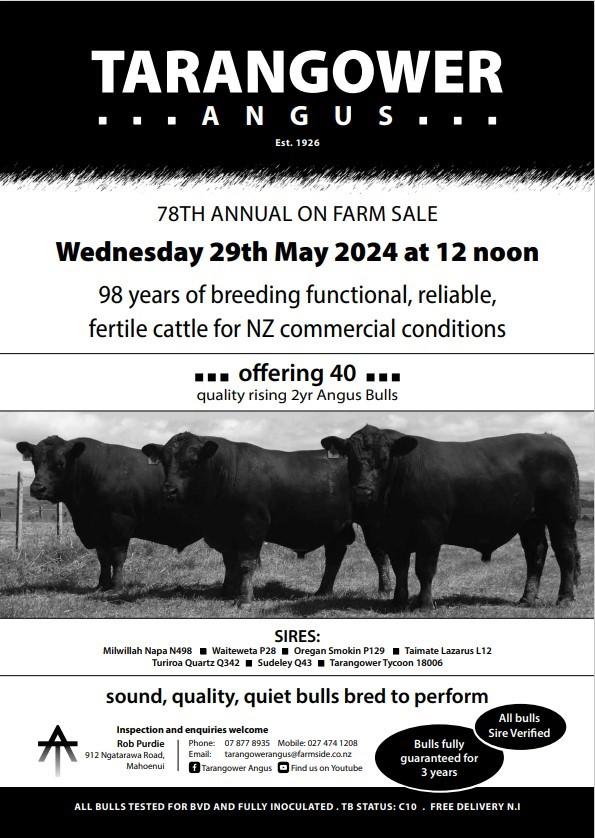
Livestock Genetics national manager said an effective breeding programme will focus on rectifying any flaws in the herd or flock, identifying what needs improving, and refining so the programme best addresses the needs of the topography, the climate and farming system of a particular farm.
Ian Valler manages a sheep and beef breeding and fattening farm that winters up to 31,000 stock units at Te Hape in the King Country, working for Te Hape B Trust and Tiroa E Trust, which holds a series of neighbouring properties, ultimately under the ownership of more than 900 shareholders affiliated to the
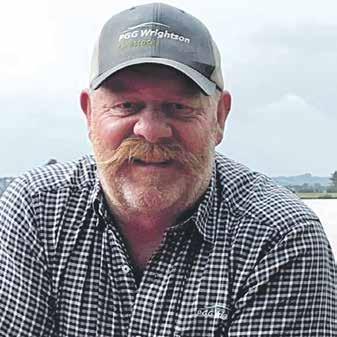

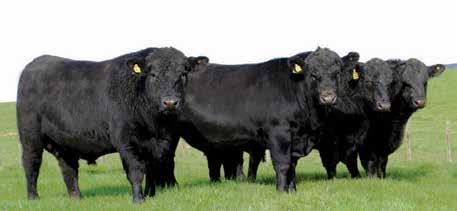



Manaipoto Rereahu iwi.
When selecting bulls and rams Te Hape B and Tiroa E Trust farms utilise the advice of PGG Wrightson Livestock Genetics.
“Callum has worked alongside us for more than 15 years. He has a clear understanding of what we need our breeding programmes to deliver.
“Our relationship operates on openness and trust. We communicate frequently and the PGG Wrightson team has a bit of scope: whatever we ask for, they will find someone who can provide it for us. We support them, and they definitely support us,” Valler said.
The genetics side of the farm has devel-
oped because of the relationship with Stewart and PGG Wrightson, and continued to develop, Valler said.
“Relationships take time and effort from both parties, though in farming the good ones can help to create substantial value in your business. This is certainly one of those relationships,” he said.
“We make decisions about our breeding programme together, after detailed discussions on farm. We all try to look at the situation objectively.
“PGG Wrightson doesn’t have ties to anyone, which makes their advice and recommendations unbiased, providing us with a trust relationship we can rely on,” says Ian.
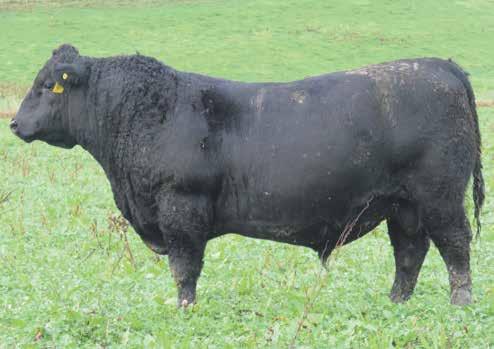
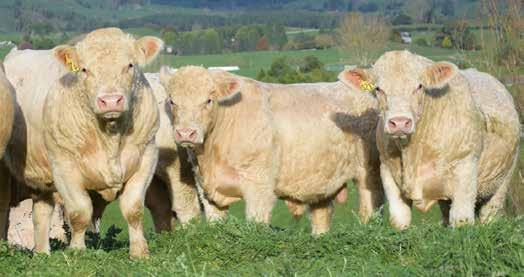
Stewart was also cautious about the bull sales prospects.
“Almost everyone on the farm is doing it tough at present, with rising costs and static or falling returns.
“That means commercial cattle farmers will be cautious when buying bulls, ensuring they make every dollar work as hard as possible. While there will be no compromise on genetics, some are likely to reduce bull numbers, mirroring what we have seen with ram sales.’
The temptation for farmers to keep any older bulls that remained sound and give them another year was strong, Stewart said.
“Last year the cow market constricted,

mainly due to conversion of land use to forestry. This year the number of cows is stable, possibly even slightly increased. So long as they have the genetics that buyers demand, breeders who have read those signals, limiting the number of bulls they offer, should meet the market satisfactorily,” he said.
Genetics was the major influence on a herd. Progeny from a bull purchased now would be born over the next three years, slaughtered over the next four, and female progeny used for breeding over the next ten years.
“Selection decisions have long-term consequences and will pay you back over an extended period,” he said.





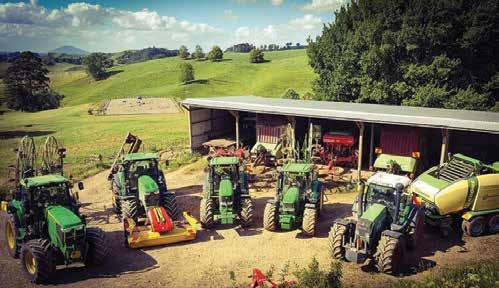




The first successful trial of a specialised tree-trimming saw hanging beneath a helicopter has been undertaken by a Te Kūiti-based company.
Trialled by The Lines Company in a forestry block at Kuratau near Taupō last month, the heli-saw successfully trimmed 950 metres of radiata pine along a corridor housing a 33kV network line in just over an hour.
Material was left at the base of the trees, leaving two blocks of trees – nine years and 14 years – undamaged.
Vegetation manager Jason Gaukrodger said the trial was “sensational”, saving the company weeks and weeks of work and thousands of dollars. It proved the heli-saw technology had incredible potential, he said.
“I had high expectations, but this blew me out of the water in terms of how efficient it was. It was much faster than I anticipated, and the pilots had incredible control.
“This technology has the potential to be transformational for electricity distribution companies like ours, as well as for the forestry sector.”
The trial of the technology will continue this month at a plantation forest south of Piopio. A 2.6km corridor through a commercial forest will be trimmed, with support from the forestry owners.
Gaukrodger said people from the forestry sector were invited to see the heli-saw in action at Kuratau and left impressed. The company would continue to work alongside foresters, he said.
“This technology helps both us and forestry owners manage the risk from trees and does so cost-effectively, especially in steep or hard-to-access terrain.
The other option is felling the trees completely, but removing edge trees opens

up forestry blocks to wind. We can send arborists in to trim trees but we are literally looking at weeks and weeks of work. With this technology, weather permitting, we’re talking hours,” said Gaukrodger.
Heli-saws are approved by the Civil Aviation Authority for use under Taupō based Lakeview Helicopters’ H125 B3E and AS350 B2 helicopters.
Gaukrodger said when considering the heli-saw, safety was the primary concern.
“We began looking at this technology a few years ago so have had time to think about every facet of safety. We’ve put a huge amount of time into health and safety documentation and into developing a helicopter guide for use on our network.
The trial itself also involved a site-specific health and safety management plan,” he said.
“This is a tool desperately needed by our industry and none of us want it to fail. It has the potential to transform the way we manage vegetation and that’s important for TLC because across our network, more and more land is now going into commercial forest.
It also allows us to reduce safety risk because we’re not having arborists up trees for extended periods of time, sometimes in challenging terrain.”
Chief executive Mike Fox said for customers the potential benefits could be huge. TLC services 24,000 connections across some of New Zealand’s most challenging geographical terrain.
Around 10 per cent of its network –approximately 150,000 hectares – is covered in forestry blocks, some poorly maintained.
The company had 269km of power lines running through forestry blocks as well as 106km of line through Department of (DoC) land.

It was an ongoing battle to keep trees clear of power lines, making the network vulnerable to storms and weather events.
“Cyclone Gabrielle is a good example of what can happen.
“Across our network we sustained around $1.65 million in damage just from that one event, and the vast majority of that cost was from trees falling into lines,” Fox said.
“In a normal year, we’d invest around $1.6 million in vegetation management but in the future, we will need to invest
more because of increasingly volatile weather patterns and the increase in commercial forestry. Over the next 10 years, we’ve budgeted a further $200,000 to $600,000 per annum to keep trees away from power lines and in some cases, reroute some lines away from trees completely.
“Those costs are huge, and at TLC we don’t have a big customer base to spread them across. The financial impact is significant, costing each customer on average $60 to $90 per year.”

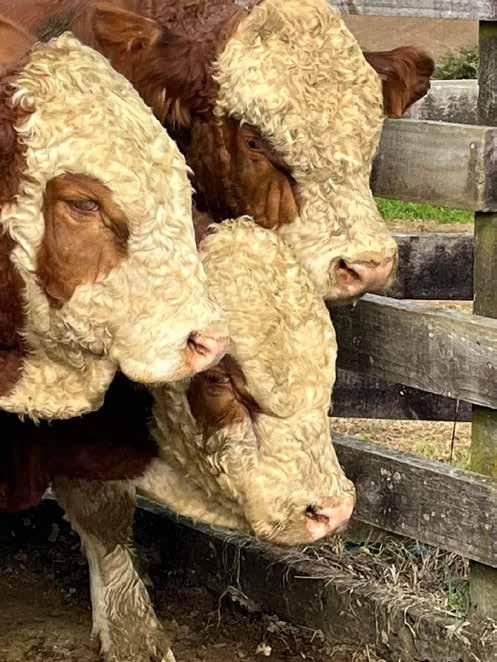

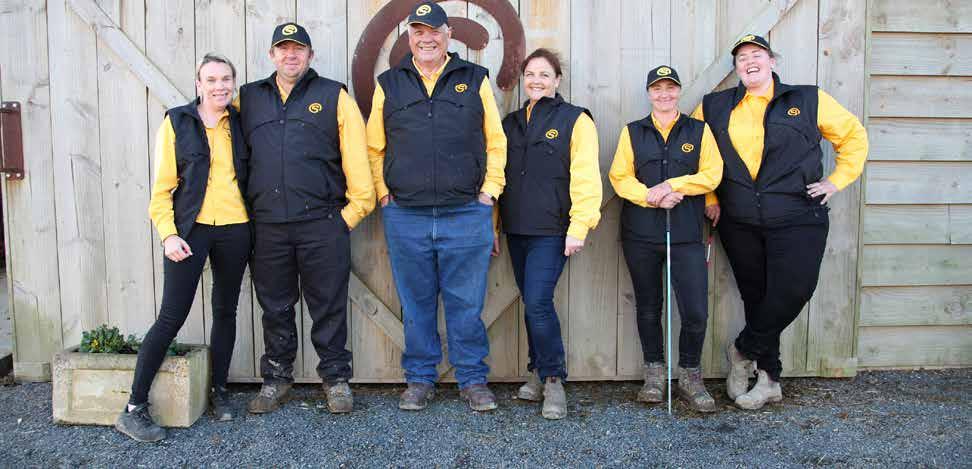



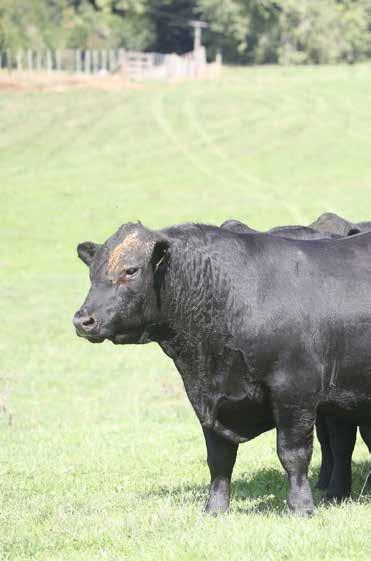




Wade Budd and David Youle had heard “whispers from the guys” about a notorious and elusive Mangakino boar lurking around their favourite spot in the bush.
So, when they turned up for weigh in at Piopio Cosmopolitan Club’s annual hunting competition earlier this month with the mysterious boar, everyone knew the great mates had been in a fight.
And so too did their hunting dog Doug –he ended up spending the night at the vets after the tussle.
The club’s competition was held from May 9-11.
Derek Tahi’s 76.1kg boar won him first prize; the best tusks category was taken out by Hiki Nathan.
In the kids’ critters section, Max Cornelissen won first prize for the heaviest hare. Koby Houghton’s possum was the heaviest, as was Angus Cowin’s turkey. Bentley Jones won a first prize for ‘overall widest goat horns.’
The competition also saw hunters and fisherfolk bringing in red stags, fallow bucks, snapper, kahawai, mallard drakes, paradise pairs, peacocks and peahens.
Wade said the boar they caught had “ripped up” quite a few of the other guys’ packs of dogs.
“We knew he was in there. We hadn’t been to that spot for a while, maybe in a year and a half, and so we went back to see if he was around, and we found him. That was pretty cool,” Wade said.
The guys are both dairy farmers: great mates and neighbours of seven years. They’ve spent that time going hunting together as often as possible, pigs, stags, “everything.”
They’re going to keep going “once the





dogs are off ACC – although they love it, 100 percent.”
Barry Stott and Waide Jones from the Cosmopolitan club said there had been 132 grown up entries into the competition, plus the kids.
“We’re happy” Stott said. “I can’t think of anything bigger we do here in Piopio, except maybe the Christmas parade.” Jones said the club would make donations to the fire brigade at Hato Hone St John, as part of their support of the community through the event.



Farmers, both dairy farm and dry stock farmers, are significantly overrepresented in the human population who suffer from Leptospirosis every year in New Zealand. For anyone who knows a person that has suffered from Leptospirosis, they will recognise that it usually life changing and at times, can be life threatening.
Affected humans’ symptoms range from severe flu like symptoms, inappetence, muscle pain, vomiting and can progress to kidney or liver disease and even meningitis.
A recent Massey University study, showed that half othe people affected by the disease are still suffering some symptoms eight months after diagnosis.
This is a zoonotic disease (transmitted from animals to humans) that we wish to stay very clear from. There is no vaccine for humans, so it is all about minimising our risk of exposure. Risk management relates to personal hygiene around urine and bodily fluids, vaccination protocols, rodent control, protecting waterways and staff training.
Like humans, dogs are not a usual host of leptospirosis. For them, this disease is often fatal because of severe liver damage. We strongly recommend that all dogs at risk are vaccinated annually.
Needless to say, pig dogs, working dogs, dogs that love playing in puddles or waterways and little terriers are extremely high risk and annual dog lepto vaccinations do save lives. Cows and pigs are designed to play host to Leptospirosis and thus can be infected but with little or

no outward signs of disease. They can then shed the bacteria in their urine or foetal fluids which can survive in wet conditions for at least nine months.
A nationwide, New Zealand 2016 study performed on a random selection of 200 dairy herds, found that 2.4% of cows had leptospirosis in their urine.


Two percent may not seem too high, but astonishingly, these cows came from 26.5% of the herds tested. We might ask ourselves, why is this so high?
By Anna Martyn Veterinarian BVSc, MACVSc King Country VetsWhilst vaccinations are very effective and help reduce the risk of shedding, they cannot cure an infection. For prevention, timing of the vaccination administration and what serovars it covers play key roles.
So, presuming that the serovar is covered, timing of administration is paramount. Calves that are exposed to the bacteria prior to being fully vaccinated, carry over cows being missed for 12 months or unknown vaccination status of other livestock coming onto the farm, can all increase the risk of cows being infect-
ed and shedding on farm.
The second key and potentially the most significant from recent findings is that the vaccine covers the serovars (type) of Leptospirosis present on farm and in the stock.
There are many different serovars (types) of Leptospirosis bacteria with the most well-known ones being Hardjo and Pomona. Most vaccines provide protection for these two serovars.
The more comprehensive vaccines also include a strain carried by rats and spread by infected urine onto feedstuff, this is called Copenhageni.
Most of our dairy farms use a vaccine with three serovars protection (Hardjo, Pomona and Copenhageni) as it has been the best defence on offered for cows and staff in contact with these animals to date.
However, as a spin off from the 2016 study, they discovered that the shedding cows were predominantly a servovar not contained in any vaccines.
Initially thought to be a serovar called
Tarassovi, it has now been identified as a new serovar named ‘Pacifica’. Given a common surface antigen, the Tarassovi provides cross protection for Pascifica as well. The great news is that we finally have Lepto 4 way, a vaccine that will cover this servovar.
What this means is, if you are after the best protection for yourself, staff and cows alike, please contact the clinic for further information on how to integrate this into your risk management plan.
New capital holding rules were now costing farmers more each year than He Waka Eke Noa was ever going to, Federated Farmers’ dairy chair Richard McIntyre said.
Federated Farmers estimate the rules add between 0.5 per cent and 1.2 per cent to rural interest rates and cost farmers an eye-watering $310m to $740m each year.
By comparison, He Waka Eke Noa was forecast to levy farmers around $255m each year. The capital holding rules were supposed to protect the banking system against a one in 200year shock, he said.
“But the question does need to be asked: could the medicine be worse than the disease?”
The accusation was part of the Federated Farmers call for an inquiry into rural banking to Parliament’s Primary Production Select Committee.










































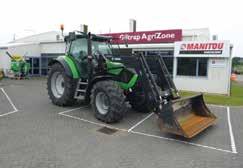











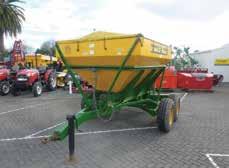
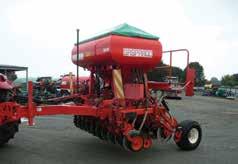


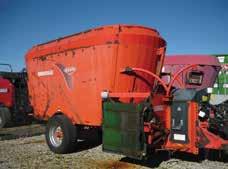



Winter is officially here, but there is still plenty to do: prep for spring crops, new rose bushes, and new fruit trees to be planted and get winter crops in the ground.
If you haven’t already planted garlic, get onto it this month. June is the best time to do this. Traditionally garlic is best planted before the shortest day of the year and then harvested by the longest day.
Autumn is the best time for planting garlic in NZ, or June for colder areas. Garlic needs around eight months to form a large, plump bulb.
Harvest too early and garlic may not have had the chance to develop separate cloves.
Seed garlic is best stored in a breathable container with fresh air and away from direct sunlight until planting. If growing from whole bulbs keep them intact until right before planting. If you’re growing from cloves that have already been broken up from their bulb then you’ll want to plant them sooner than later.
Garlic is a heavy feeder that enjoys full sun and requires fertile soil to perform at its best and produce big fat bulbs.
To get the best results from your
garlic patch it should be planted in well-fertilised free draining soil. Prepare your garden beds in advance of planting by generously adding lots of organic matter such as aged compost, potting mix, and/ or manure a few weeks in advance of sowing your garlic. A layer of mulch on top of your garden bed is also great for insulating the developing garlic bulbs from extreme temperature changes over the growing season.
If you haven’t added heaps of organic matter to your garlic growing beds then a trick employed by commercial growers is to dig or trench down 200-300mm at planting time and add sheep pellets or guano or bone flour to the bottom of the hole/ trench at a rate of roughly a small handful each hole.
Fill in the hole/trench with loose soil to form a cushion for your garlic cloves to sit on when you plant them, leaving about 50mm from the top of the hole for planting.
Plant your cloves at 200mm –300mm apart with the pointy side up/ tip up with approx. 50mm - 75mm of soil covering the planted tips of each clove, and fill your hole/trench back up.
This week’s column proudly sponsored by

 By Chris Gardner
By Chris Gardner
They gave their lives in the world wars, now Te Kūiti High School will remember them.
Te Kuiti High School received a pictorial roll of honour from Te Kūiti and District Memorial Returned and Services Association (RSA) president Barry Batley last month.
The display has been carefully researched and complied by RSA vice president Ross O’Halloran, a Lance Corporal and section commander in the Hauraki Company of 3/6 Royal New Zealand Infantry Regiment.
The roll of honour includes the names of 27 former Te Kūiti High School pupils who fell in World Wars I and II.
O’Halloran has found photographs of seventeen of them, used photographs of four headstones and four branch of service badges. For two, O’Halloran has found no service records at all.
“Hopefully people may come forward with photographs of those I haven’t been able to find photographs, and we can update them as we go along,” he said. “I’ve set it up so this can be done.”
O’Halloran is currently researching the Auckland Infantry Regiment from World War I and is hoping to complete similar projects for RSAs from Kawhia to
Taumarunui.
So, why bother?
“Good question,” said “O’Halloran. “I never charge for it, and it can take quite a bit of time.”
His late father, Jim, was a Gunner in 42 (Te Kuiti) Battery, 4 Medium Regiment during the Compulsory Military Training scheme of 19491958.
“Dad never missed an ANZAC Day parade, leading Te Kūiti Pipe Band as drum major and he had known a number of Boer War, World War I and World War II veterans so due to that I grew up knowing many local veterans,”
O’Halloran said.
“My kids have not, neither will future generations, so it is one way to remember them and their sacrifices. They are not just names on a cenotaph, they were a human being and had loved ones.”
O’Halloran, who has also been active in the RSA Poppy Appeal for years, made a similar roll of honour for Te Kuiti Primary School last year.
“He’s done a very good job, and it’s something for the young ones to look at,” Batley said. “It’s great to involve as many local people as possible, the older ones who have done so much over the years are thinning out.”
 Te Kūiti and Districts RSA president Barry Batley, Te Kūiti High School principal Gareth Williams, head boy Mitchell Hedley and head girl Jasmin Holmes with the pictorial Roll of Honour.
Te Kūiti and Districts RSA president Barry Batley, Te Kūiti High School principal Gareth Williams, head boy Mitchell Hedley and head girl Jasmin Holmes with the pictorial Roll of Honour.
King Country mayors are encouraging rate payers to check whether they qualify for rates relief before applications close on June 30.
The formula used assesses household income, number of dependents and the level of rates being paid.
“The funding for this rates rebate scheme comes from central Government,” Waitomo mayor John Robertson said.
“The Government has increased the amount that can be claimed and I would encourage those eligible to apply – our council can assist with this.

“The cost of living crisis is with us in Waitomo and so I think it’s really important that those in need don’t miss the opportunity to engage with this scheme,” Robertson added.

In the 2022/23 rating year Waitomo paid $229,662.49 out in rates rebates to 347 Waitomo residents.
Ōtorohanga mayor Max Baxter said his council took the initiative in February to reach out to ratepayers who had not applied for a rates’ rebate in the past two years.
He said the council’s community outreach programme called Pop-Up Council was going out to different parts of the community each month to make council services more accessible for the district.
“And a big part of this work is ensuring our communities know about rates rebates and how to apply for one.”
Ōtorohanga had 213 approved applications for the 2022/2023 rating year, paying out a total of $129,000.
Ruapehu mayor Weston Kirton said with the rate rebate being worth up to $750 it provided important financial support for many.
The number of people applying at Ruapehu varied from year-to-year which possibly indicated that

some who could qualify were missing out.
“It is important to note that because personal circumstances change you need to apply for the rate rebate every year, even if you have previously been successful in gaining one,” Kirton said.
In the 2022/23 rating year Ruapehu helped return $370,000 to 571 rebate ratepayers.
“So far for the current 2023/24 rating year we have received 457 applications worth almost $318,000 suggesting there are ratepayers who could benefit who have not yet applied.
“We are hopeful that we can exceed last year’s total and see even more Ruapehu whānau benefit from the scheme,” Kirton said.
More than $1500 was raised from donations and raffles during a Pink Ribbon Day fundraiser at the Mōkau Hall on Sunday.
Nearly 50 people turned out equalling about half the population living at Mōkau Village and its immediate surrounds.
“This was the first Pink Ribbon fundraiser we’ve ever run. We had no idea how many would come so we had a pot luck brunch and the food was just amazing,” said an organiser Heidi Preston.
“We shouldn’t have worried because in the end just about everyone who could come, did come.
“Locals here support everything – there’s so much enthusiam to tap into in small centres like Mōkau.”

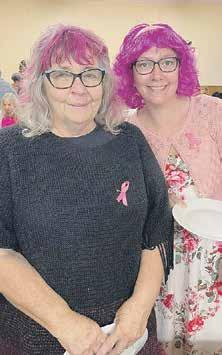
YSAGRONOMYQDTAIUXY MCTHFGGZDREAMYMBVM GAYOSLKYPGFAMUIYKR YIMCREAMYMNMMGMYLO PGUOEMYOYAUMAOAMMW ALEHHFYSTRYMNSSRYK LAHPIRTOKFYOTDAERD CYRTGEMBLHGRYDZDIR HMSYRYMYYAOMYOPIAA EYTYMMXMMNXJCZZXDY MMFYYELYOYSEQYSAFM YAUTGANMCMTBMHJTMR KCHIBOYEYQEMIEBCZA TAYDLSLIMYAMMYSELF UDMVVEMOHLMMUEFGOX MELFDACSCYYMGLOOMY MMILDMIYVYMCYMIRGF YYFPTYJQMYMHRRYMVY


Playcentre Piopio’s 60th birthday celebration drew 70 people to share memories and fun times designed for the littlies.
Children enjoyed face painting, a bubble machine and a bouncy castle while adults made the most of the barbecue.
Peta Vassalini, who sits on the Playcentre Aotearoa board of trustees, came for the celebrations and said she was proud to be out supporting rural communities, and bringing
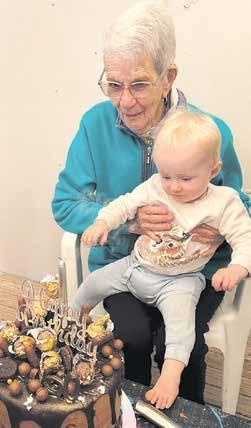
them together,
“As we’ve done for the last 80 years.”
Guest Jean Dickinson was the first secretary of Piopio Playcentre when it was in the Presbyterian Church Hall and “just a mother helper.”
Mrs Hoy was the supervisor, she said.
Her favourite memory from that time was when water play was first offered, courtesy of a big container kept outside.
“The look on the children’s faces when they were allowed to play with water.”
Elaine Teale first came to the playcentre in 1977 and two years later was involved in the move to the current building, next to the stream.
“At that time, I was a mum with a little baby, and my friends and I got together, and we decided we needed a new playcentre, with a proper building.
“We were tired of moving things from the basement to the hall and back again, and we had too many kids there, so a group of us got together, and we did fundraising and we got this one built.
“We worked with (King Country MP) Jim Bolger and he helped make it happen – he and another man Charlie Tennant at the education board in Hamilton.
“When it opened, I was the first teacher here, helping the kids.
“In those early days, the dads were very helpful, looking after the kids during the committee meetings. They helped to put in the gardens and build the sandpits and the garage,” she said.
“Putting down concrete- all those sorts of jobs. They did a lot of physical work, they did whatever we wanted them to do. But a lot of the girls had worked on farms, so they joined in the physical work too.

“We were all used to being partners with our husbands and doing everything together as a partnership. We didn’t have to do too much bossing. We just showed them the plans.
“They decided what they wanted to do, we decided what we wanted to do, and we all did it together.”
All interviews and several photos were completed by King Country New’s very own junior reporter, Saskia, 10. When she’s not engaged in child labour, she is a year 6 leader at Āria School. More photos kingcountrynews.co.nz

Te Kūiti’s water plant failed last Thursday night, which resulted in two meat plants halting production and the Waitomo council issuing urgent conserve water notices.
The town relied on reservoir capacity while staff worked to located repair the problem.
Mayor John Robson said the fault was located and repaired about 2am.
“One of the issues we face in Te Kūiti is that these storage tanks do not hold much more than a day of water under normal usage,” he said.
“As a precaution, plans were made to have water tanker filling stations set up for Friday morning.”
It turned out a faulty analog card - a device within a control system that relays signals to other systems to make something operatecaused the plant to shut down.
The card was replaced and required repairs made.
“Te Kūiti’s drinking water plant is relatively new, and so the risk of serious failure is low,” Robson said.
“That is not the case for our underground drinking water network of pipes, or our reservoirs.
Some infrastructure is old.
“We need to upgrade this and increase the capacity of our reservoirs to store water.”















There’s no doubt about it, if you are thinking of yourselves or your parents in later years and the idea of a retirement village doesn’t really appeal, this is one of those rare opportunities to purchase a quality home.
Amenities are within an easy reach, including the supermarket and local café, a service station opposite for a quick loaf of bread and the doctors at the opposite end of the street.
Refurbished to a very high standard, this home has had a full facelift including a modern kitchen, in-ceiling heat-pump for a better air
flow, new one run carpet, a beautifully tiled bathroom with wet-floor shower, the inclusion of a separate laundry and a full interior paint.
A compact section allows a private area for entertaining as well as a covered veranda plus all day sun is guaranteed.
Our realistic vendors are moving nearer family and will miss this great community.
Call us today to plan a viewing.
Open home is Sunday, May 26, 2– 2.30pm
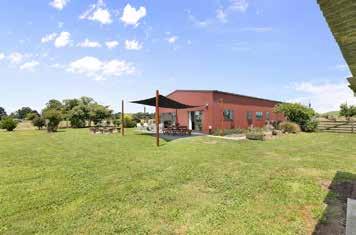


| 12 Te Kanawa St, Ōtorohanga
I 471m2
| 2 bedrooms,1
PRICE | $619,000 LICENSED AGENT | Harcourts Ōtorohanga
LICENSED SALESPERSON | Karen Lennox 027 559 4468 Kerry Harty 027 294 6215
WEBSITE | harcourts.co.nz
WEB ID | OH22456


Ōtorohanga
00 SHWY 31, Kawhia Road
Located just 1.5 kms west of Otorohanga this 3.4613 hectare block has the potential for a multitude of possible land uses given its proximity to town and prominent main road location. With a safe and easily accessible entranceway off Redlands Road with a haybarn and set of cattle yards already in place this really is an opportunity that must be explored.
For Sale $550,000
View blueribbonharcourts.co.nz/OH22463

Ōtorohanga
57 Main North Road
Entry level buying with benefits or just a move in another direction, this family sized home has the bonus of a new roof, an additional sunroom/study/sewing or hobby room plus an area set aside just for the adults with a ensuite bathroom. Warm in winter and cooler in sun, the clever addition of a basement main bedroom has proved popular with the current owners who are looking to relocate.
For Sale $589,000
View blueribbonharcourts.co.nz/OH22393

Ōtorohanga 192 Mangawhero Road

Sun, 3.30-4.00pm

Kerry Harty 027 294 6215 kjharty@harcourts.co.nz

For Sale
$1,090,000
View blueribbonharcourts.co.nz/OH22438


Quality lifestyles don’t get much better than this attractive 288 sqm home. A well-designed kitchen and scullery, two living areas with fabulous outdoor entertaining space, four bedrooms (the main with His & Hers walk-robes) and beautifully tiled bathrooms. A high stud and over-height doors all add to the overall aesthetics. Three car garaging, 4056 sqm and well laid out mature grounds. Sat, 11.00-11.45am Sun, 2.45-3.15pm
Karen Lennox 027 559 4468 karen.lennox@harcourts.co.nz
with workshop. Just enough space for a pony, with 5900sqm of land.
For Sale $849,000 View blueribbonharcourts.co.nz/OH22459

Ōtorohanga

12 Ballance Street For Sale $540,000 View blueribbonharcourts.co.nz/OH22436
Renovated and redecorated throughout, with double glazing, near new roof and offering a spacious dining area with separate lounge. Wet-room plus a second separate toilet off the laundry. Insulated both underfloor and in the ceiling, with a wood-burner to warm the house in the winter months, and a ducted heat-pump for summer cooling.
Set on 1.2748 hectares with the Marokopa River on the boundary, ‘Awamarino’ is a 3 bedroom home, rich in character and charm with a sleepout/guestroom operating as a successful Air BNB. Great shedding includes a 180sqm half round barn/workshop + a 3 bay shed. Whitebaiting and summer recreational activities are sorted!
For Sale $480,000 View blueribbonharcourts.co.nz/OH22455
Whether it be a larger lifestyle or easy to manage support property for a nearby farming operation, this 28.3057 hectare bare block located just 7kms from the Piopio village is not going to disappoint. Well subdivided and central raced with ample hay country we have no doubt the contour is going to impress, numerous building sites, north facing views, no building or land use covenants.




















Otorohanga, 8105sqm rural lifestyle section. Phone Julie $370,000 Lots 90-108 Harpers Avenue, 486sqm to 962sqm, Westridge II subdivision. Phone John From $220,000ea Te Kūiti sections (sizes are approximate)
54A Ailsa Street (Lot 1), Te Kuiti, 2159sqm, end of a cul de sac, STT. Phone Buzz By Negotiation
54A Ailsa Street (Lot 2), Te Kuiti, 1707sqm, end of a cul de sac, STT. Phone Buzz By Negotiation
Other sections (sizes are approximate)
0 Raglan Road, Kawhia, 2648sqm lifestyle section, no covenants, completely off grid. Ph Julie $340,000 neg
147 Maukutea Drive, Kawhia, 600sqm, covenants apply, services at drive, water tank on site. Ph Julie $375,000
20C Parihoro Road, Pirongia, 5004sqm (STT), 4 bay shed wired for power, bore water. Ph Cherie $450,000
254B Pekanui Rd, Pirongia, 1.9225ha, 12min drive to Pirongia village, covenants. Ph Cherie or Noldy $295,000
194E Pekanui Rd, Pirongia, 1.9973ha, 12min drive to Pirongia village, covenants. Ph Cherie or Noldy $355,000 171 Ngahape Road, Te Kawa, 5001sqm, power at





































Well positioned opportunity
Three bedroom, weather board home set on a flat, low maintenance, 1,012 m2, fully fenced section. Built in 1938 the home is set back from the road behind a low rise, concrete art deco style fence, an attractive property with great street appeal. All bedrooms are of double size as is the lounge, bathroom and laundry and storage in every room. A single garage/workshop with power and concrete floor plus oodles of room for the kids to play safely in the fully enclosed garden. Alternatively develop the yard with raised garden beds, fruit trees or additional shedding. The rear corner of the property adjoins Kiwi Street and a second access would be ideal for future section development.






Cul-de-sac location
Drive on in to this 1960's built property to the carport to ensure you're not getting wet when taking the groceries out of the car.
The 80 m2 footprint is generously set out in an open plan format, with viewing and conversations to be had from the dining room to the lounge or kitchen areas and ample space for family or visitors. Three bedrooms with a decent sized master bedroom for the head of the household. Great porch for your boots and ample clothes space in the laundry. Picturesque views from every aspect of the home and a well landscaped, free draining 1,113 section. Deadline sale (unless sold prior), vendor looking at offers over $380,000.
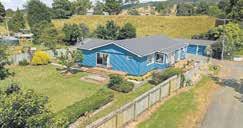






DEAD OR ALIVE
$$$$




E orchardworx@gmail.com
E rustytipping@gmail.com
P.O. Box 301 Mangonui 0442 | Irrigation – Design, Supply, Install | Headworks, Automation, Filtration, Fertigation | Earthworks | Artificial Shelter | GPS Mapping | Agricultural Fencing | Livestock Water Supplies


Accom Available
Room for rent Piopio. Ph 021 0845 4198.
HOUSE for rent Te Kūiti. Three bdrms + carport. $400 per week. 3 weeks bond required. No pets. Non smokers. Ph 027 480 9981.
26 Queen Street, 2 Bedroom $370.00 per week
2/41 George Street, 2 bedroom + carport $300.00 per week
70a Mountain View Rd, 3 bedroom + garage $525.00 per week

Angeline (Buzz) Linn 115 Rora St, Te Kuiti Apply in office (Ray White)
Land for Sale Maize or Graze 18.9 Ha SH3 Kio Kio All flat, central race, bore water 13 Paddocks, yards, hayshed Dave Kilbride, Bayleys 027 436 7082 Property For Sale
Servicing Ōtorohanga

SEAN CURRAN
ROOFING
Specialising in re-roofing, roof maintenance, spouting, downpipes and light commercial work and roof leaks Ph 027 493 2502
Email: nigel@npg.co.nz Need a qualified and

Ph Nigel 07 878 7877 027 674 3396

Grazing Available GRAZING AVAILABLE for up to 50 R2 Dairy grazers. Experienced grazier. Refs available. May to May ongoing. Based south of Te Kūiti. Ph or Text Jason 027 6200 893
For Sale
FIREWOOD - Ph Sonny 021 617 349 or 07 873 9190.
FIREWOOD for sale. Gum, Lawson, Mac mix, shed stored and ready to burn, $110 per cu or $1250 for bulk 13cu load, local delivery included. Text 027 371 8474

9104 decorator@daverowe.co.nz
School
Amazing office manager required! Our wonderful Office Manager of 14 years has decided it is time explore life outside of working. We are looking for a wonderful person who:
• Enjoys children
• Gets on well with a variety of people
• Has a great smile and good sense of humour
Previous school office skills would be an advantage. The role is part-time (up to 20 hours a week) Monday to Friday, and hours are negotiable.
For more information regarding this position or to apply contact: Jacqui Coogan
Email: principal@benneydale.school.nz Phone 027 623 8912

Servicing the Waipa and Waitomo districts for over 20 years
Sick of having things stolen? Need somewhere secure to store chemicals? Purchase a 10, 20 or 40 foot container. Contact PGF Transport for details. Phone 07 878 3622 or 027 223 9246 or email o ice@pgftransport.co.nz
& mould treatments, Chemwash, waterblasting, gutter vac, water tank and trough cleaning fences, retaining, odd jobs and more. References available GST registered. Mike & Allana 027 350 0836 info@handy-man.co.nz






SENIOR DAIRY ASSISTANT
Experienced person required to join team milking 1000 cows through a 70 bale rotary cowshed. Located 20 minutes from Oto and Te Kūiti. Accomodation available. Contact us on 027 485 3773
To rear calves as part of a team. Drive in position Located 20 minutes from Oto and Te Kūiti. Contact us on 027 485 3773
•
•
•
•
•
• Word processing
• Electronic filing
• Assist with employment contracts
• Assist with health and
• Printing, scanning, photocopying
• Minute taking
• Boardroom facilities
• Other administrative duties

$20 Adult / $5 Child (under 14) door sales Concert & Dinner: $60 Adult / $30 Child (under 14) tickets. Available until 19 May from juliehwards@ gmail.com Ph 027 527 1744



Customer Service Centre - Our Service Centre will close at 4pm Friday 31 May and reopen at 9am Tuesday 4 June. Our call centre operates 24/7. For After Hours services please call 0800 932 4357.
WDC Admin Building - Closed.
Waitomo District Library - Closed.
Waitomo District Landfill and Awakino Transfer Station - Closed.
Kinohaku, Piopio, Marokopa and Maniaiti/Benneydale Transfer Stations - Closed.
Kerbside Refuse and Recycling Collection Services - There are no kerbside collection services on Monday.
All other Transfer Station services will be available during the weekend as per normal.
Waitomo District Council Staff wish you all a happy and safe holiday weekend!
PIOPIO ARIA GOLF CLUB INCORPORATED, 1686 State Highway 3, Piopio has made application to the District Licensing Committee at Te Kūiti for the renewal of a club licence in respect of premises situated at 1686 State Highway 3, Piopio and known as Piopio Aria Golf Club Incorporated. The general nature of the business to be conducted under the licences is that of a sports club. The days on which and the hours during which alcohol is to be sold under the on-licence are Monday to Wednesday 10am to 10pm, Thursday to Saturday 10am to 12 midnight, Sunday 10am to 11pm.
The applications may be inspected during the ordinary office hours at the office of the District Licensing Committee at Waitomo District Council, Queen Street, Te Kūiti. Any person who is entitled to and wishes to object to the issue of the licences may, not later than 25 working days after the date of the publication of this notice, file a notice in writing of the objection with the Secretary of the District Licensing Committee at Waitomo District Council, PO Box 404, Te Kūiti 3941. This is the only publication of this notice.


Te Kūiti and District Memorial RSA would like to express our gratitude and thanks to all those involved in giving and collecting for the Poppy Day appeal.
A special thank you must go to Michelle and team at Waitomo District Council and to Amanda and team at the Waitomo Club for their support in making our Anzac Day so special in the remembrance of the fallen. LEST WE FORGET
To keep this day continuing and alive we need your support. Please do inquire about RSA membership at the Waitomo Club.
ONWARD
B J Batley
President
WAITOMO CLUB INCORPORATED, 10 King Street East, Te Kūiti 3910 has made application to the District Licensing Committee at Te Kūiti for the renewal of a club licence in respect of premises situated at 10 King Street East, Te Kūiti and known as Waitomo Club Incorporated. The general nature of the business to be conducted under the licences is that of a chartered club. The days on which and the hours during which alcohol is to be sold under the on-licence are Monday to Sunday 9am to 1am the following day.

The applications may be inspected during the ordinary office hours at the office of the District Licensing Committee at Waitomo District Council, Queen Street, Te Kūiti. Any person who is entitled to and wishes to object to the issue of the licences may, not later than 25 working days after the date of the publication of this notice, file a notice in writing of the objection with the Secretary of the District Licensing Committee at Waitomo District Council, P. O. Box 404, Te Kūiti 3941. This is the only publication of this notice.
Have something you need to photocopy?
We offer a wide range of photocopy and printing services at very competitive prices – in fact we are the cheapest in town! Bring your own paper or choose from our wide range of speciality paper and card. Call in and see us now at 18 King St East, Te Kuiti
ŌTOROHANGA CRAFT MARKET
SUNDAY, MAY 26 9AM - 2PM
Fourth Sunday of every month, sites available!
Contact Alison Shardlow 027 303 9582 email huntingdale507@gmail. com
Last Sunday of every month
Email jim1@xtra.co.nz or ph Jim 027 366 5842
St Luke's Anglican Church Te Kūiti Morning Prayer Service followed by AGM All welcome
Pirongia Community Centre, Crozier St Sunday, May 26, 9am - 1pm Phone parish office 07 878

AGENDA
Karakia Timatanga
Mihi
Financial
Chairmans
General
Karakia whakamutunga
King Country Grey Power Inc

Monday, May 27, 2024 @ 2pm
St Lukes Church, 85 Esplanade, Te Kūiti
Presentation by Heartlands Services – available services and facilities Members and residents aged 50yrs and over welcome Quick fire raffles, Sales table Meeting followed by shared afternoon tea
Waitomo District Rates Reminder
This is a friendly reminder that the fourth instalment of your 2023/2024 rates is due by Friday, 31 May 2024. Rates invoices were posted out recently. A penalty charge of 10% will be added on any part of the instalment which remains unpaid on the due date.
Rates payments can be made at the Customer Service Centre at 160 Rora Street, Te Kūiti, over the phone or through our website by credit card, or by Internet Banking using your valuation number as your reference.
Please contact our friendly Customer Services Team at 0800 932 4357 or info@waitomo.govt.nz for further assistance.
Ben Smit Chief Executive www.waitomo.govt.nz


Ōtorohanga.
BAPTIST CHURCH

Ranfurly St, Ōtorohanga Service times Sunday 10.30am Everyone welcome Contact 07 873 8685
ARIA MŌKAU CO-OPERATING PARISH All Saints 22 Moa St Every Sunday 10am Service
St Peter’s By The Sea, 25 Aria Tce, Mōkau 1st and 3rd Sunday 2pm Service
Piopio contact: 07 877 8097 Mōkau contact: Mrs Dorothy Lowry 06 752 9123
DON’T
LISTER, Tony: Peacefully in hospital in the UK after a short illness. Dearly loved brother of Malcolm and Sheila, much loved Uncle of Andrew and Wendy and their families. Friend to many in New Zealand, met during his frequent visits. Rest in peace Tony.
SCOTT, Roberts Kenning Melmoth (Mel): On Monday, May 20, 2024 at Bethlehem Views, Tauranga (late of Taupō and Ōtorohanga). Aged 96 years. Loved husband of the late Elspeth. Cherished father and father-in-law of Thomas and Jill, Jane and Torben, Peter and Anna, Susan and Martin, Ben and Richelle. Special granddad to 11 grandchildren and 10 great grandchildren. A celebration of Mel’s life will be held at St Bride’s Anglican Church, Haerehuka St, Ōtorohanga on Thursday, May 23 at 11am, followed by a private cremation. The Scott family wishes to thank Beattie Home nursing staff and Bethlehem Views for their wonderful care and love to Mel. In lieu of flowers, donations can be made to the Ōtorohanga Kiwi House. All communications to Scott Family C/- PO Box 241, Te Kūiti 3941. In the care of VJ Williams & Sons FDANZ.
ANDERTON, Peter Michael: Peacefully at Te Kūiti Hospital on Monday, May 20, 2024 with his loving wife at his side. Aged 70 years. Dearly loved husband of Sue. Loved and cherished father and fatherin-law of Jason, Melissa and Mike Howarth (Mosgiel), Jo and Greg Strain (Brisbane). Special GP to Ella and Jack Howarth. “Always Remembered”. A private family farewell has been held. All communications to Anderton Family C/- PO Box 241, Te Kūiti 3941. VJ Williams & Sons, Funeral Directors Association of NZ
CEDERMAN, Myra Amelia: Passed away peacefully on Wednesday, May 15, 2024 at Te Kūiti Hospital, with her family by her side. Dearly loved wife of the late David. Loved mother and mother-in-law of Wayne and Kathleen, Malcolm and Lynette and Craig. Cherished Nana of nine grandchildren and four greatgrandchildren. According to Myra’s wishes, a family service and burial at Ōtorohanga has been held. All communications to The Cederman Family, c/- 262 Ohaupo Road, Te Awamutu 3800.

Nau mai Haere Mai Ki te hurikohatu o Anaru Tamati Taane.
your FREE Garage Sale sign when you place your garage sale classie ad in the King Country News. Ask our friendly receptionist.

Saturday, June 1 Te Kuiti Pa (Meet at the bottom of the gate) 10.30am - Whakatau 11am - Unveiling
12. 30pm - Te Kūiti Quota Club
Everyone is welcome to join us for lunch, and to catch up with whanau
Arni’s legacy was always about whanau and staying connected.
From our whanau we have no words to express our love and support that we have received over the past year, and we are so deeply grateful.

LINCOLN, John: On Sunday, May 19, 2024 at his home, Te Kūiti surrounded by his loving family. Aged 82 years. Loved husband of Ngaire for 48 years. Cherished father of and father-in-law of Joanne, Jae and Pan, Jinnina and Patrick, Michael and Melisa. Adored stepfather to Debbie and Terry, David (dec), Rosanne and Shane, Stacey and Elaine. Special granddad to 18 grandchildren and 14 great grandchildren. A celebration of John’s life will be held at Les Munro Centre, Te Kūiti on Thursday, May 23 at 11am, followed by a private cremation. In lieu of flowers, donations to St John Te Kūiti would be greatly appreciated. All communications to Lincoln Family c/- PO Box 241, Te Kūiti 3941. In the care of VJ Williams & Sons FDANZ.
Lincoln, Graham John: Sunrise 20/11/41 until Sunset 19/5/24 Beloved second son of the late Trevor and Connie Lincoln. Much loved brother and brother in law of Ray and the late Anne Lincoln and beloved uncle John to their children Tracey, Sheryl, Karen, Alison and Scott and their families. One of life’s gentlemen with the biggest
and



